Cooking at home has always been my mantra. I love cooking for my family and friends. From street food to fine dining food, I like to explore the ingredients that go into a dish so that I can replicate it in our kitchen at a later time.
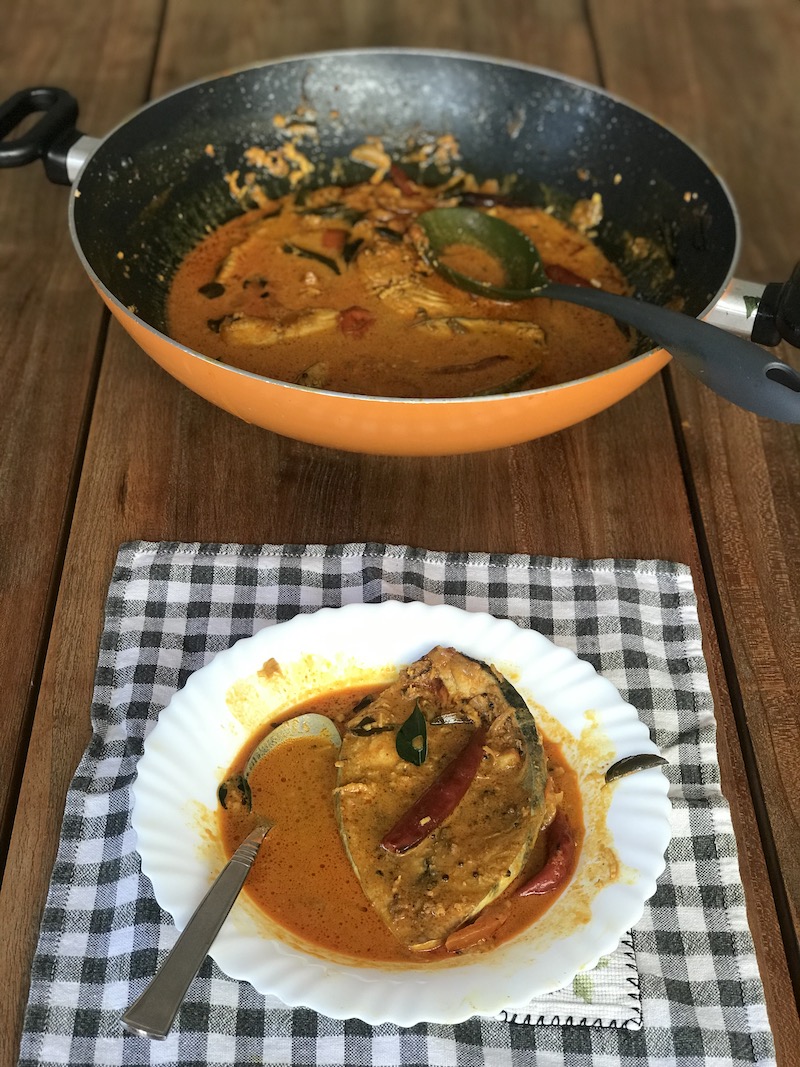 Meen Kuzhambu / Kulambu, fish gravy cooked in tamarind, coconut milk and spices
Meen Kuzhambu / Kulambu, fish gravy cooked in tamarind, coconut milk and spices
Contrary to what most people think, we aren’t eating Bengali food at home every day. In fact, the Z-Sisters won’t have it that way and I am guessing neither the Bearded Biker and I would too. At least, not all the time. A meal or two over the weekends does revolve around Bengali food or a bit of Kolkata nostalgia – sometimes Chinese the way its made at popular food kiosks in Kolkata – Karunamoyee or around City Centre in Saltlake, or in one of the legendary Park Street restaurants like Bar-B-Que. Although the look, feel or taste of the former is completely different from its latter counterpart! Then there’s Italian food. I believe that I cook Italian food quite well. At least, that’s what the Z-Sisters say. I find cooking Italian food extremely easy. Also, they turn out so exotic just by adding fresh herbs or a homemade sauce. Currently, I am making pesto very often from fresh basils that are plucked at beck and call from our garden. I stir them into pasta or grilled chicken, drizzle a little olive oil … and Eccoci… our delicious meals are ready (some other post, some other day)!
Exploring regional dishes from South India
To simplify this blogpost, I’ve decided to focus on the new flavours I’ve been exploring after settling down in our Chennai home. During the weekdays, the Z-Sisters bombard downstairs around 11:30 am – 12:00 pm, demanding lunch. Big Z is lucky to have attended school physically for two months until the schools were closed down by the Tamil Nadu government once again, as a preventive measure. Lil Z has been attending online schooling for over a year now. The Bearded Biker is also going to mark a year of working from home. I just told him the other day, that I am getting spoilt with the thought of them staying at home and coming together during mealtimes – a sort of a happy thought for me. Initially, I would cook familiar and easy-to-make dishes during weekdays – stir fries, fried rice, hotpots and grills. The weekends were reserved for slightly more elaborate affair. Since the time Matree, our wonderful live-in lady has joined us, I have been on a spree of exploring regional cuisine. Matree is a Tamilian, born and brought up in Kerala-Karnataka border and is an exceptional cook. Although quite young, she reminds me of traditional home cooks like my dida or mum-in-law who insist on using freshly ground masalas and don’t believe in fast tracking the steps in cooking a dish.
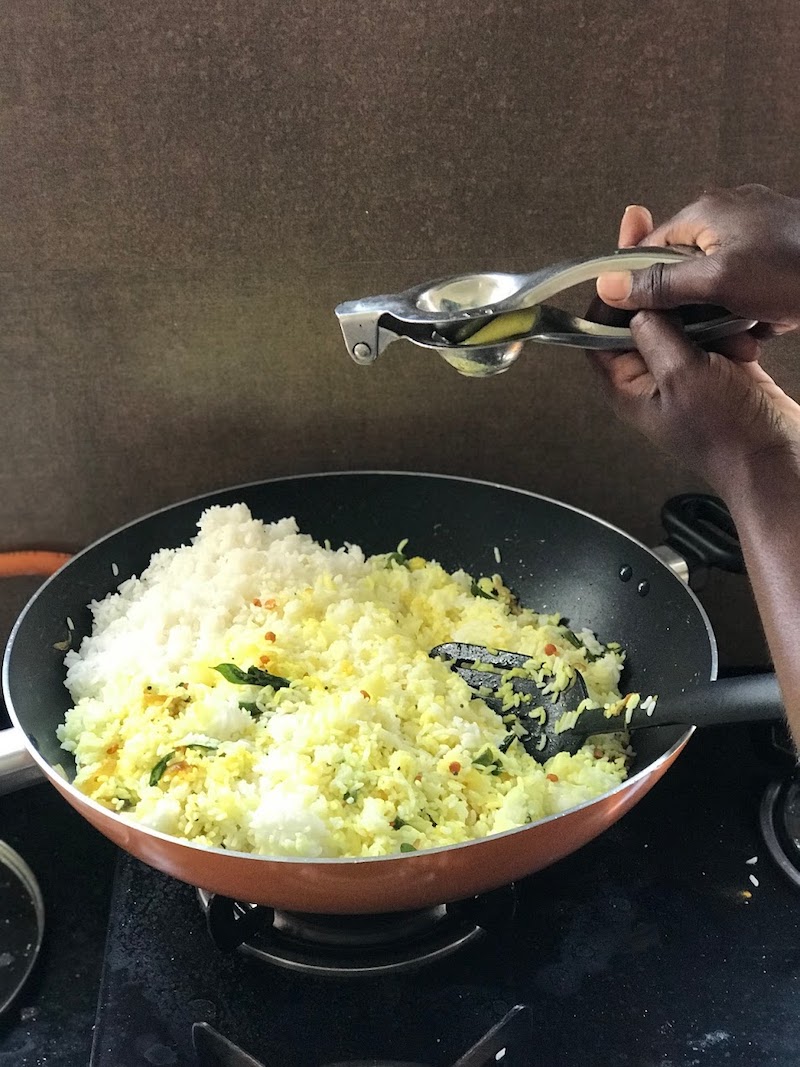 Lemon Rice, a delicate and fragrant rice preparation
Lemon Rice, a delicate and fragrant rice preparation
Cooking from scratch
I had intended to teach Matree Bengali cooking … gradually of course, just like Lady M but have now decided to keep my mission on hold. We are enjoying the variety of regional dishes so much, that I don’t want to overburden her by educating her on Mustard Oil, Jharna Ghee and other nuances of Bengali cuisine. Also, Matree’s stock seems to be endless as of now and she effortlessly moves within the different states of South India. Like traditional home cooks, her requirements for kitchen utensils are also very traditional. Whereas for years, I had ‘managed’ with a coffee grinder for grinding my fresh masalas or non-stick woks for the tempering, Matree insists on what she is used to… a Preethi mixer grinder or a proper tadka pan for ‘thalippu’ or tempering. The chai has to be ideally made in a saucepan (no brown sugar for her), the fresh milk is boiled in a Pigeon Milk Boiler and the curries are made in a heavy kadai. Every other day, we have an Amazon delivery for Matree’s list. I had simplified my kitchen life by giving up on all the miscellaneous gadgets and utensils that I thought required a bit of TLC, that is tender, love and caring. My intention is to delegate the daily cooking and all kitchen related activities to Matree, so that I can re-focus on my writing. Therefore, I am indulging in our Amazon spree to the hilt. The pantry room adjoining our main kitchen resembles a ware house store… new pots, pans, ladles and a whole lot of kitchen items. Initially, my favourite instruction to Matree was, “manage”. Translated, this meant using whatever we already had, which were anyway proliferating out of the kitchen boundaries into the cabinets in our living room and dining room. I have now realised, that for Matree to operate at her full potential, she couldn’t be asked to ‘manage’. She wouldn’t compromise in cooking and every step had to be done from scratch and at home – be it fermenting the Appam mixture overnight or making Idi Appam noodles at home. No more store bought ready made batters and mixes!
Every night before winding down, as Matree and I decide on the next day’s menu, I ask her to think of a local dish that we haven’t tried yet. I also leave the regional menu pairing to her… if I suggest something that doesn’t go well, she will often reject that. I am in no hurry to teach her Bengali cooking. I also have all the time in the world to savour all the new taste and flavours that she’s bringing to our table. It was only once that I couldn’t resist putting her puri making skills to test and asked her to make perfect phulko luchis to go with our weekend’s kasha mangsho, the slow cooked tender goat meat (as shown below)!
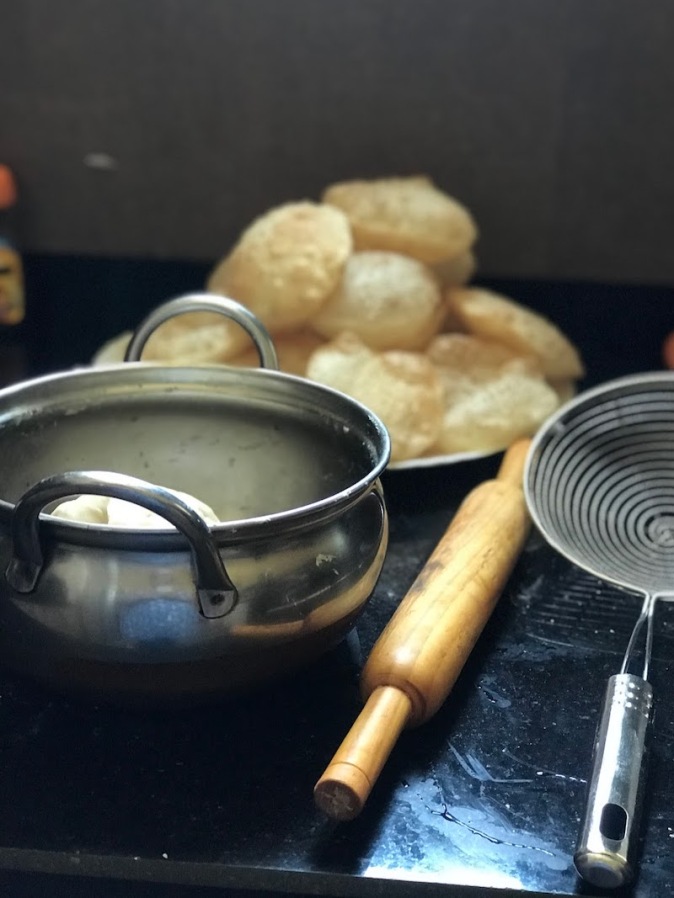

Beyond Rasam… delicious snapshots of our home cooked meals… 50 shades of rice, lentils and Poriyal. Curry leaves for thalippu or tempering, and of course as garnish.
“So, you will be eating Rasam now?” “Are you eating Curd Rice and gun powder?” “No more Mustard fish… only idli, sambhar and dosa?”
We have been such a vocal non-vegetarian family so far, we are constantly being drowned with stereotypical questions like above… as if coming to Chennai was a culinary exile. To be fair, I didn’t expect to learn so many non-vegetarian preparations as I have done over these few months. A quick search on Google would reveal that 97.65 percent in Tamil Nadu are non-vegetarians. An impressive statistics in comparison to West Bengal holding the percentage at 98 percent!
My notion had been laid astray by most of the Tamilian friends we have had – Brahmins who are vegetarians. If only we had an association with anyone from the Chettinad region or the coastal area, we would have been prepared for the delicious onslaught of non-vegetarian food that was perhaps in store for us in Chennai.
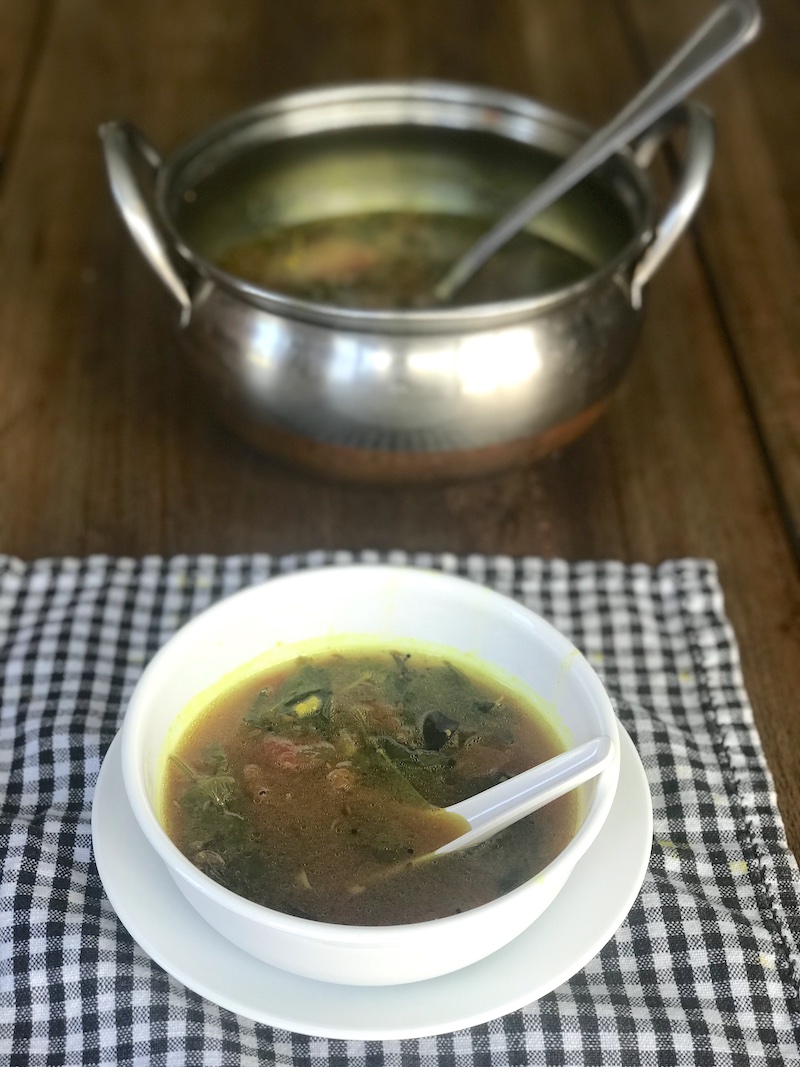 RASAM. Soup style! The urge to have an authentic Rasam made at home became almost like an obsession after hearing umpteen number of times by actress Deepika Padukone that her favourite food is Rasam and Rice. Moreover, with Rasam having gone ‘viral’ in the US as the “immunity boosting soup”, thanks to chef Arun Rajadurai who worked in Anjappar Princetown, I had to learn what made Rasam so special. The thing is, there is no single Rasam recipe. Rasams not only differ with ingredients but also across families and provinces in South India!
RASAM. Soup style! The urge to have an authentic Rasam made at home became almost like an obsession after hearing umpteen number of times by actress Deepika Padukone that her favourite food is Rasam and Rice. Moreover, with Rasam having gone ‘viral’ in the US as the “immunity boosting soup”, thanks to chef Arun Rajadurai who worked in Anjappar Princetown, I had to learn what made Rasam so special. The thing is, there is no single Rasam recipe. Rasams not only differ with ingredients but also across families and provinces in South India!
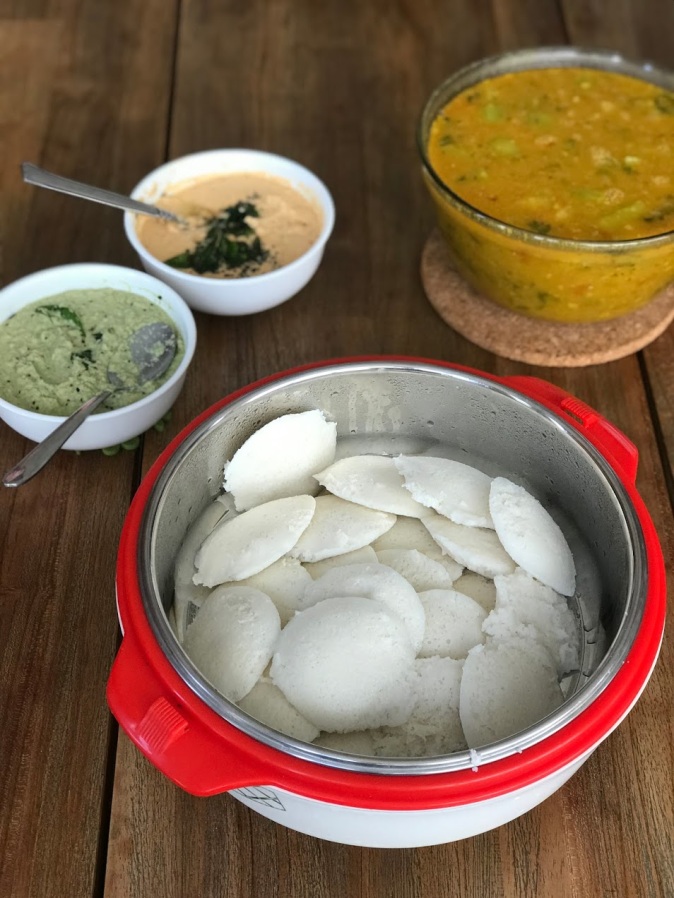
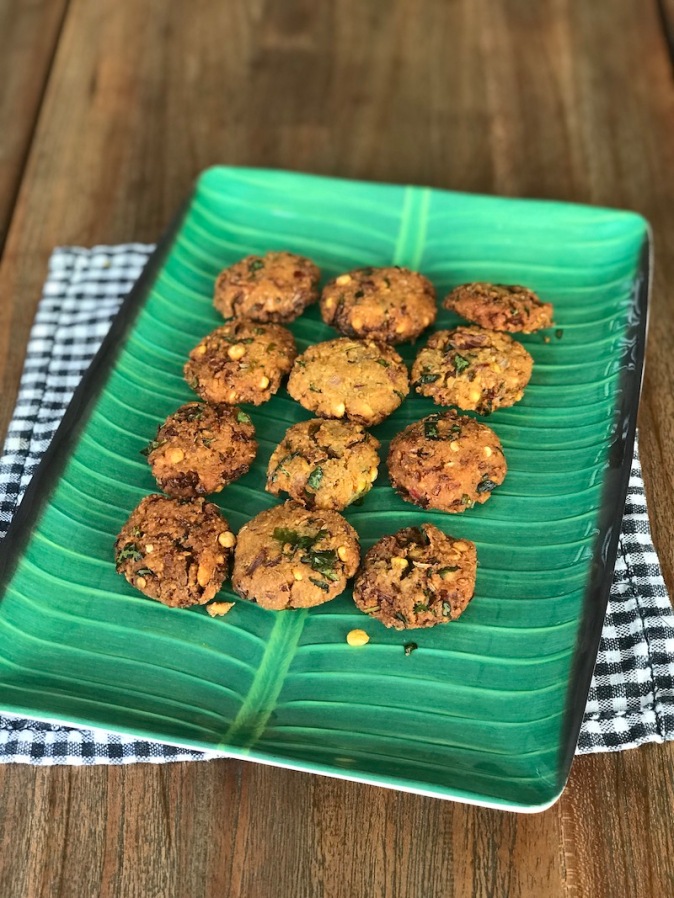
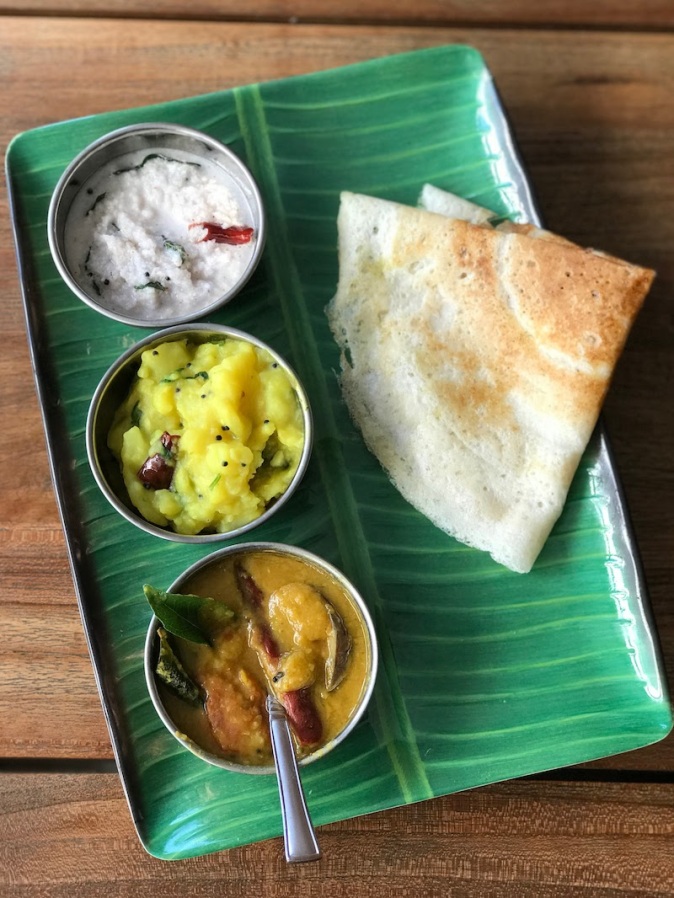
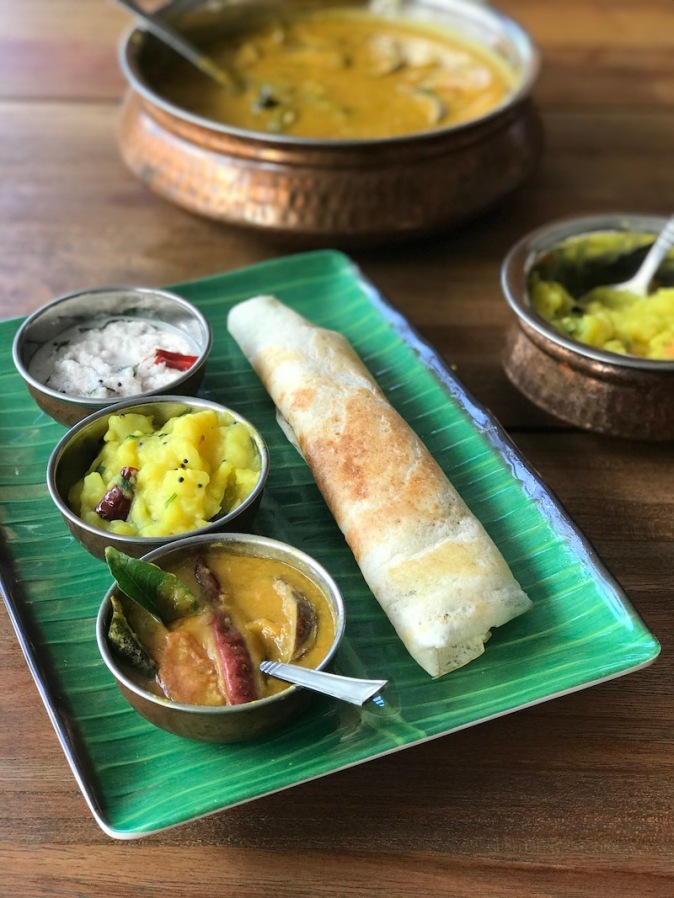
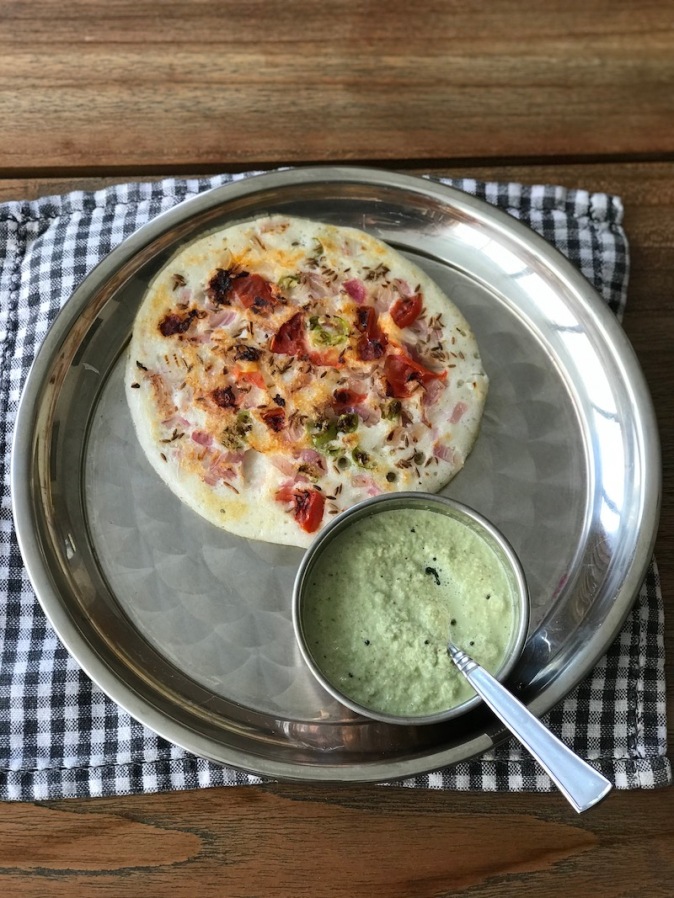
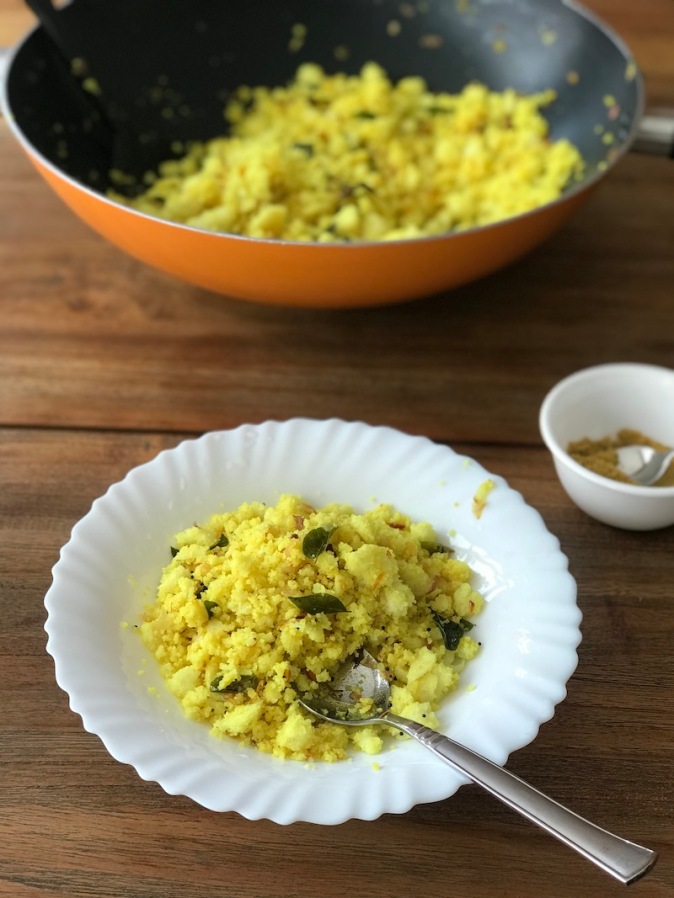 Idli, Masala Vada, Medu Vada, Masala Dosa and Uttapam served with sambar and a variety of fresh coconut chutneys comprise the array of “tiffin”. The different coconut chutneys make for an interesting taste variations and I learnt that the Thengai chutney is the white coconut chutney with only the thalippu or tempering of roasted Bengal gram, green chillies, mustard seeds, urad dal, curry leaves and asafoetida. The red coconut chutney had roasted Sambhar onions (shallots), red chillies, garlic, ginger, roasted chana dal and curry leaves. Fresh coriander leaves, green chillies and a dash of lime went into the making of the green coconut chutney along with the usual tempering. The Idli Upma (last image above) is a brilliant makeover with left over idlis and adding the usual thalippu or of mustard seeds, curry leaves and channa dal.
Idli, Masala Vada, Medu Vada, Masala Dosa and Uttapam served with sambar and a variety of fresh coconut chutneys comprise the array of “tiffin”. The different coconut chutneys make for an interesting taste variations and I learnt that the Thengai chutney is the white coconut chutney with only the thalippu or tempering of roasted Bengal gram, green chillies, mustard seeds, urad dal, curry leaves and asafoetida. The red coconut chutney had roasted Sambhar onions (shallots), red chillies, garlic, ginger, roasted chana dal and curry leaves. Fresh coriander leaves, green chillies and a dash of lime went into the making of the green coconut chutney along with the usual tempering. The Idli Upma (last image above) is a brilliant makeover with left over idlis and adding the usual thalippu or of mustard seeds, curry leaves and channa dal.
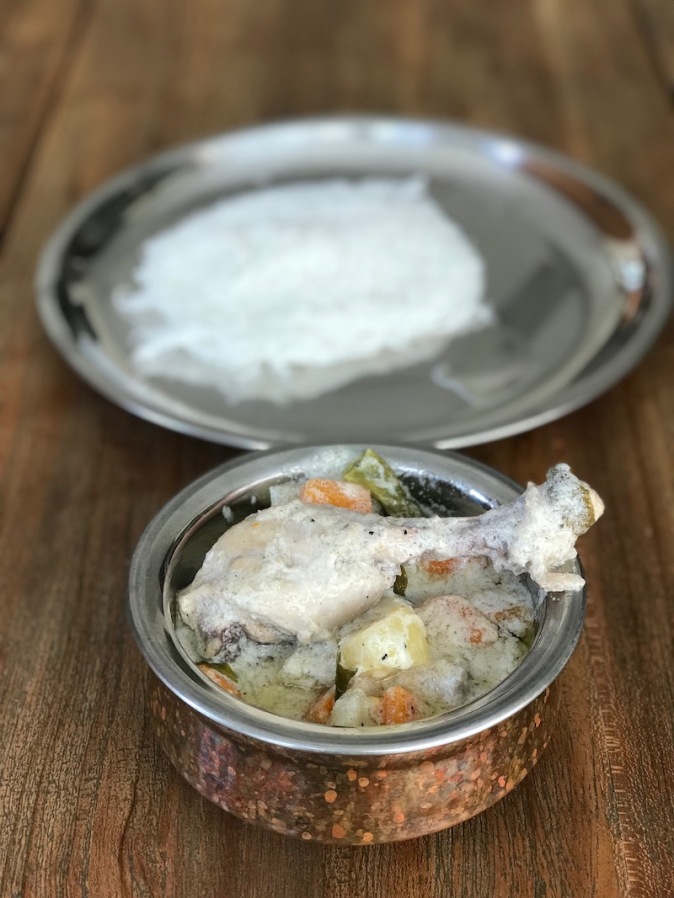
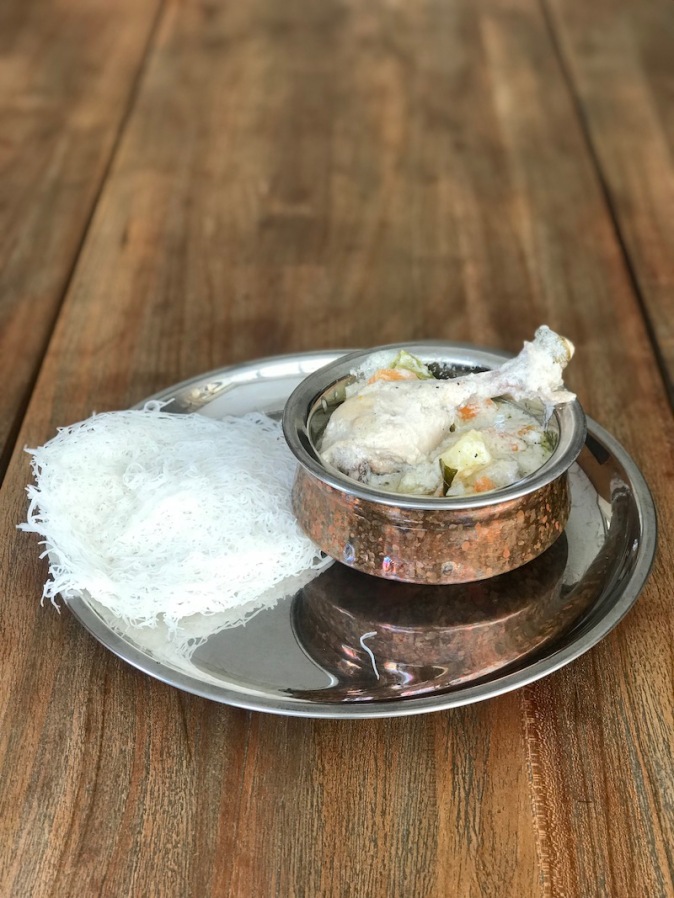 Idiyappam with Chicken Stew with coconut milk
Idiyappam with Chicken Stew with coconut milk
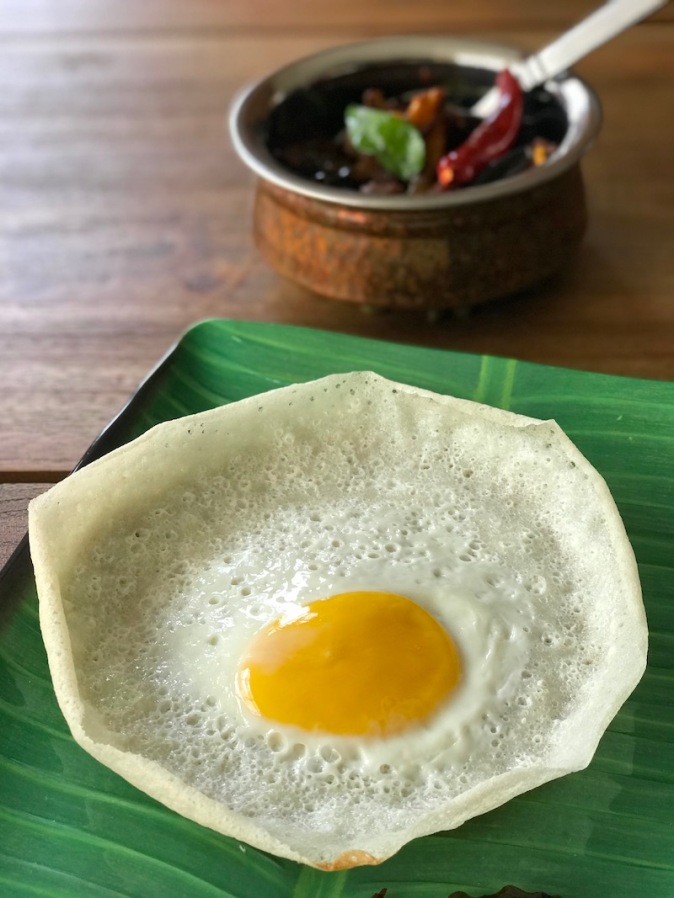
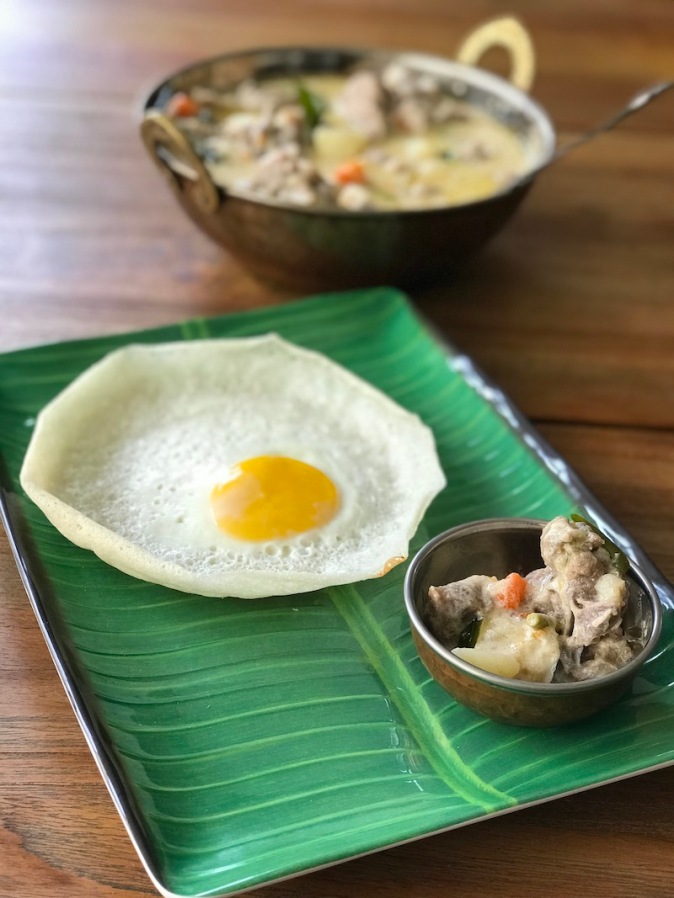
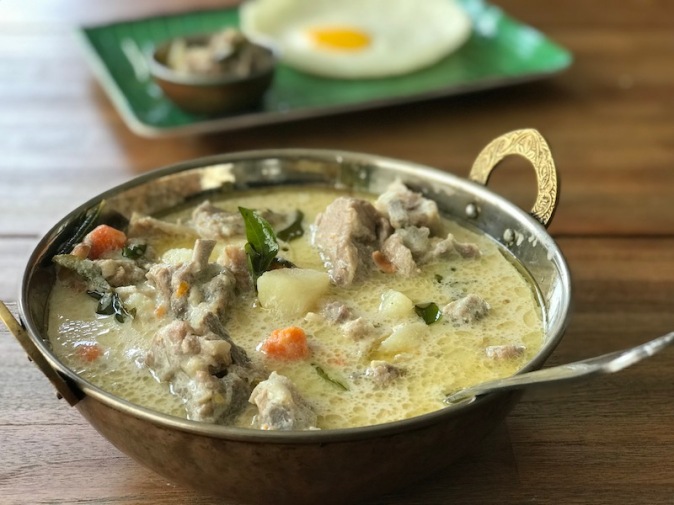
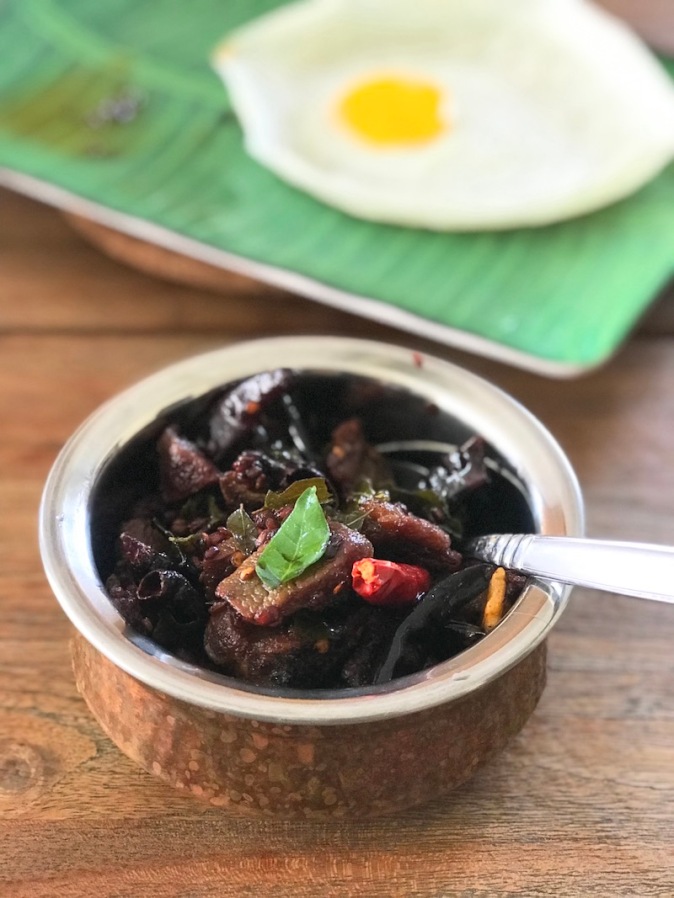 The Bull’s eye Appam with a fried egg in the middle is definitely a culinary fine art… and can be had with either the light Mutton Stew or the spicy Mutton Sukha, although both preparations have contrasting taste profiles. Cooked in the Kerala style, the chicken and the mutton stew tastes surreal with a thick coconut gravy and the subtle fragrance of bay leaf, ginger, fried onions and whole black pepper.
The Bull’s eye Appam with a fried egg in the middle is definitely a culinary fine art… and can be had with either the light Mutton Stew or the spicy Mutton Sukha, although both preparations have contrasting taste profiles. Cooked in the Kerala style, the chicken and the mutton stew tastes surreal with a thick coconut gravy and the subtle fragrance of bay leaf, ginger, fried onions and whole black pepper.
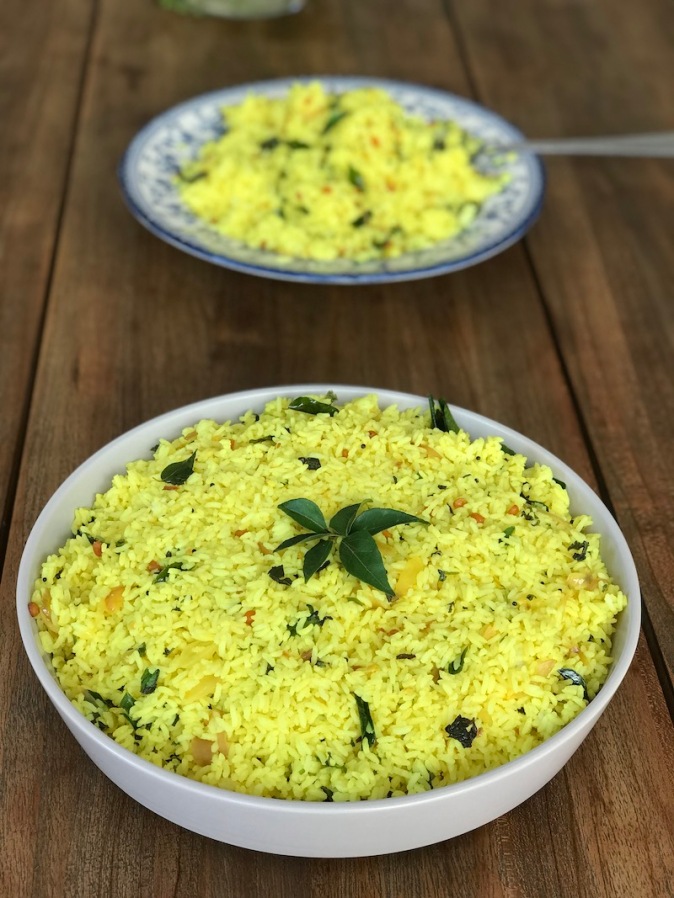
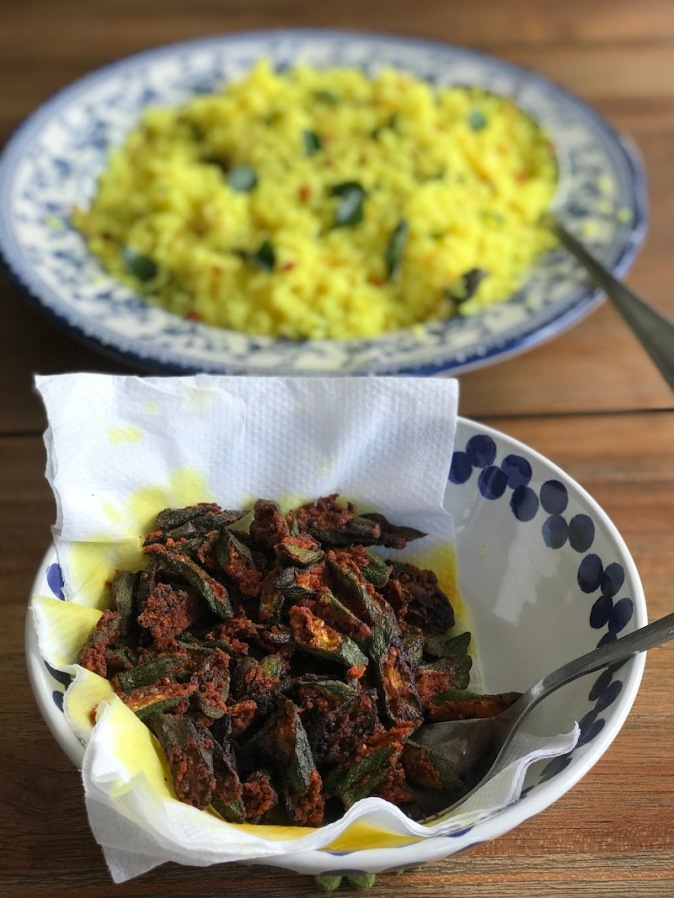 Lemon rice cooked in the Tamil style, paired with a crispy fried spicy okra.
Lemon rice cooked in the Tamil style, paired with a crispy fried spicy okra.
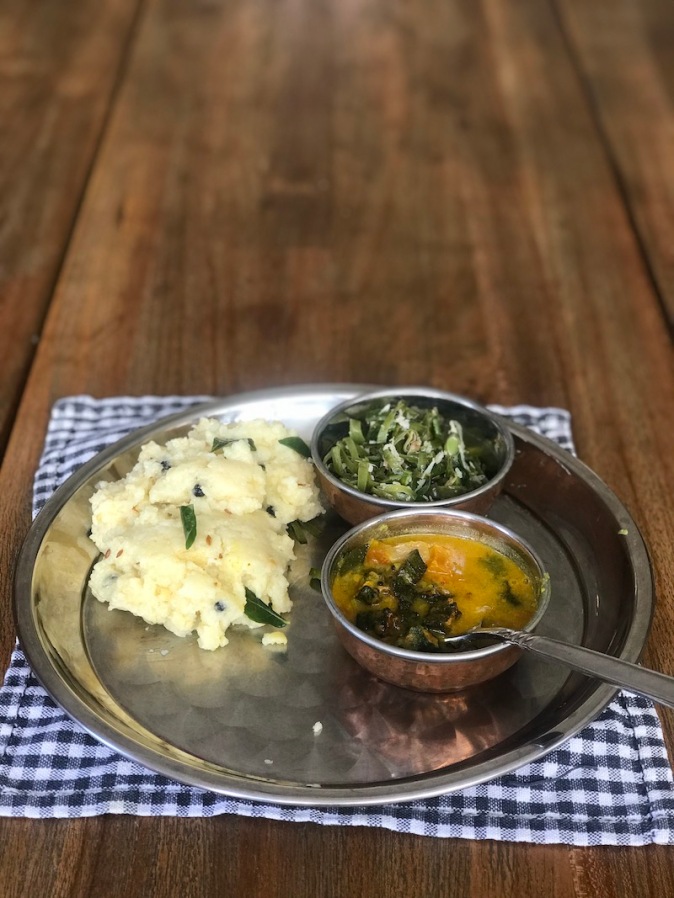
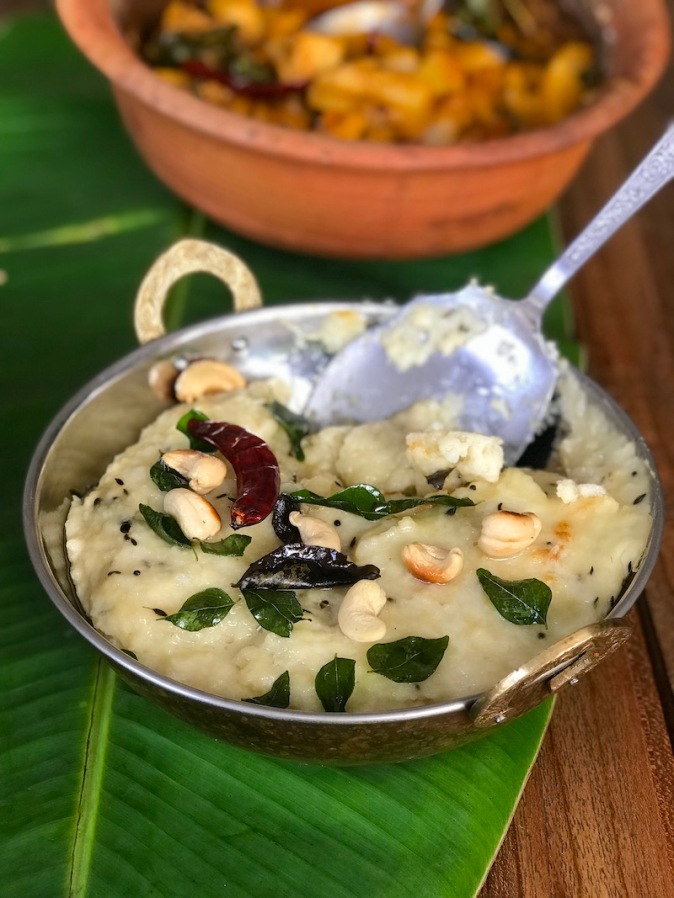 Ven Pongal with Sambar and a Poriyal made with beans (first picture above) and with Kara Kulambu or Kara Khuzambu (second picture above and also below), an extremely spicy and tangy preparation of a mix of vegetables.
Ven Pongal with Sambar and a Poriyal made with beans (first picture above) and with Kara Kulambu or Kara Khuzambu (second picture above and also below), an extremely spicy and tangy preparation of a mix of vegetables.
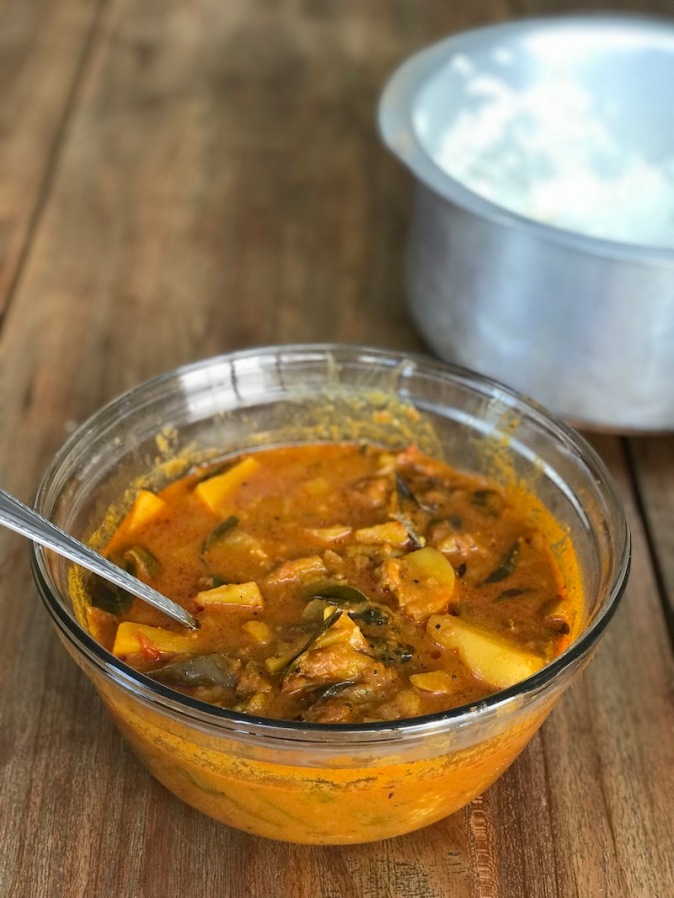

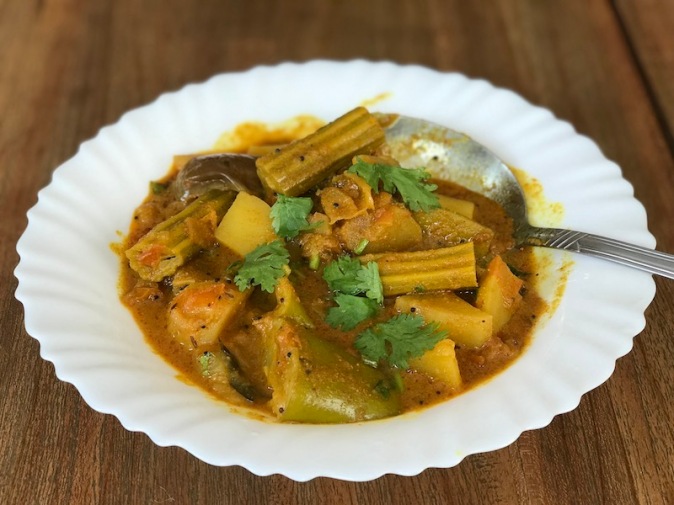 White rice makes the perfect accompaniment to the spicy Kara Kulambu. Like many variations of Sambar, Matree sometimes had her own renditions of Kara Kulambu – like in the above, where she added green mangoes, drumsticks and fresh coriander leaves.
White rice makes the perfect accompaniment to the spicy Kara Kulambu. Like many variations of Sambar, Matree sometimes had her own renditions of Kara Kulambu – like in the above, where she added green mangoes, drumsticks and fresh coriander leaves.
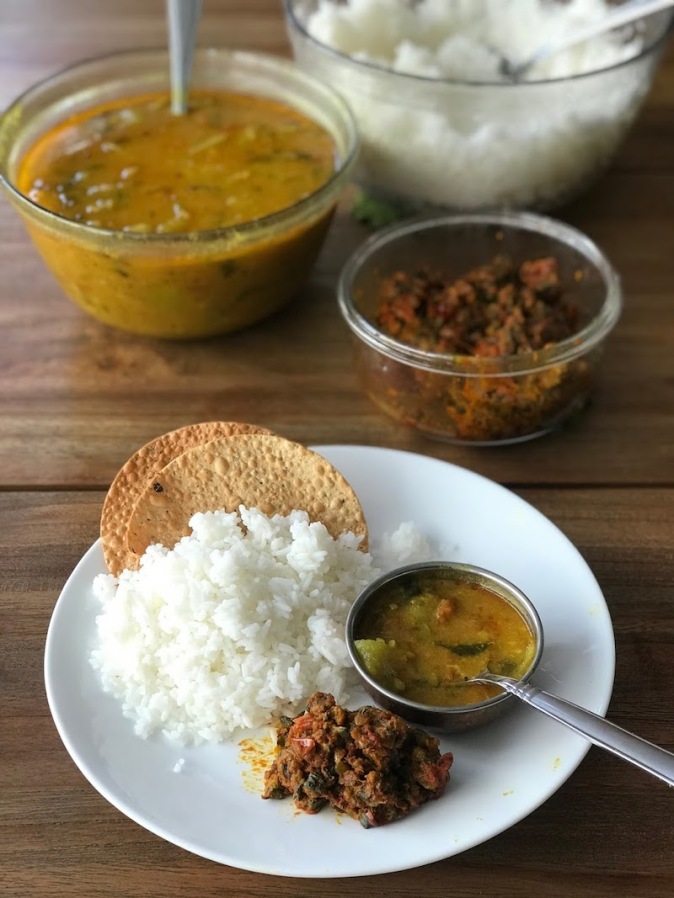 White Rice with Dal, spicy Bitter gourd Poriyal and Papad
White Rice with Dal, spicy Bitter gourd Poriyal and Papad
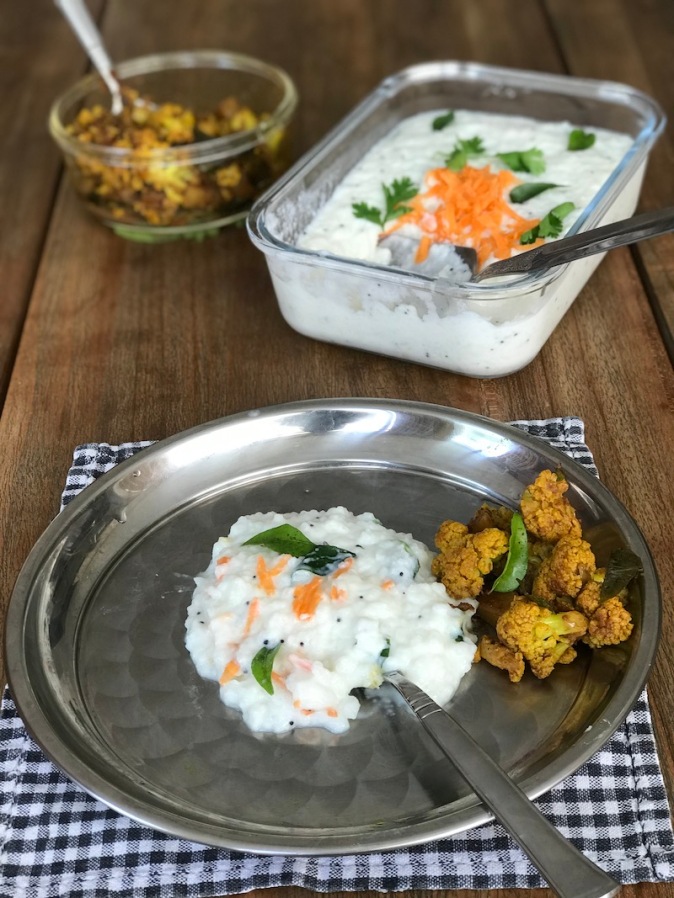
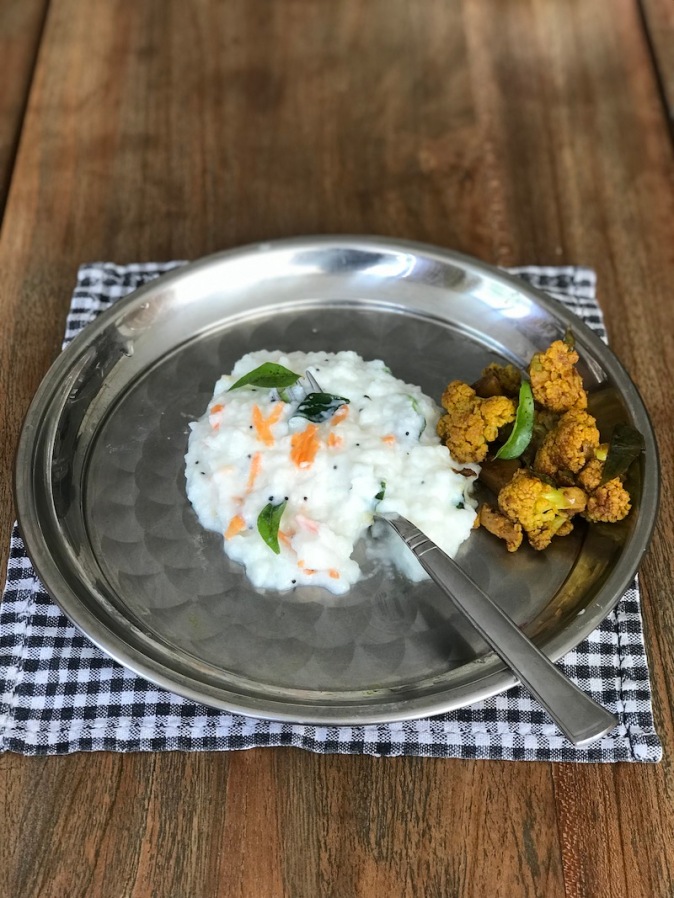 Curd Rice with Masala Cauliflower Poriyal
Curd Rice with Masala Cauliflower Poriyal
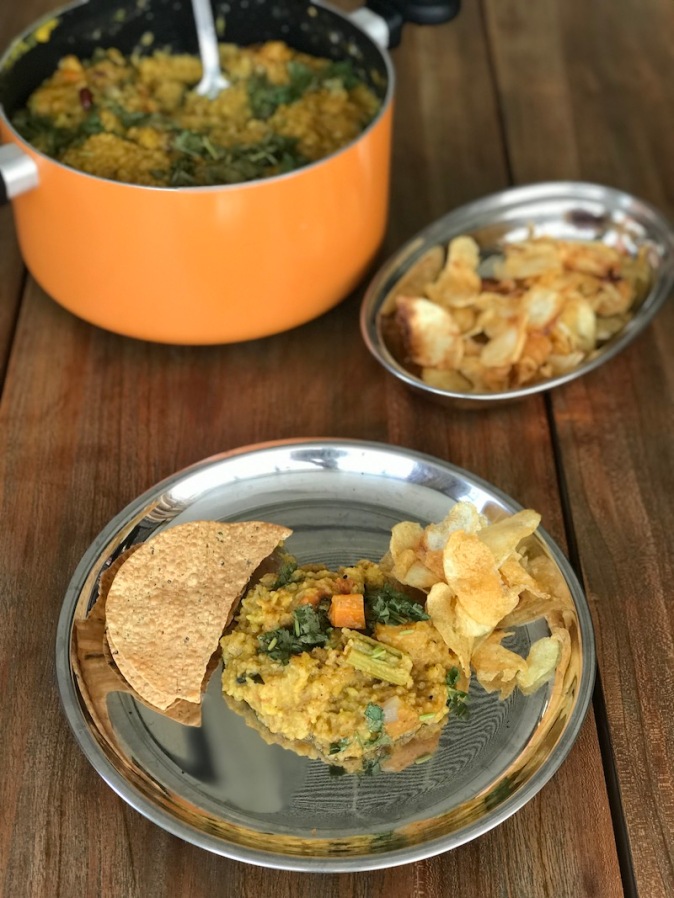 Bisi Bele Bhath with homemade potato chips and Papad is Matree’s favourite. Bisi Bele Bhath is a spicy lentil and rice dish that has its origin in Karnataka. With lots of vegetables thrown in the dish, I felt that Bisi Bele Bhath could well be described as a spicier version of the Bengali Khichuri.
Bisi Bele Bhath with homemade potato chips and Papad is Matree’s favourite. Bisi Bele Bhath is a spicy lentil and rice dish that has its origin in Karnataka. With lots of vegetables thrown in the dish, I felt that Bisi Bele Bhath could well be described as a spicier version of the Bengali Khichuri.
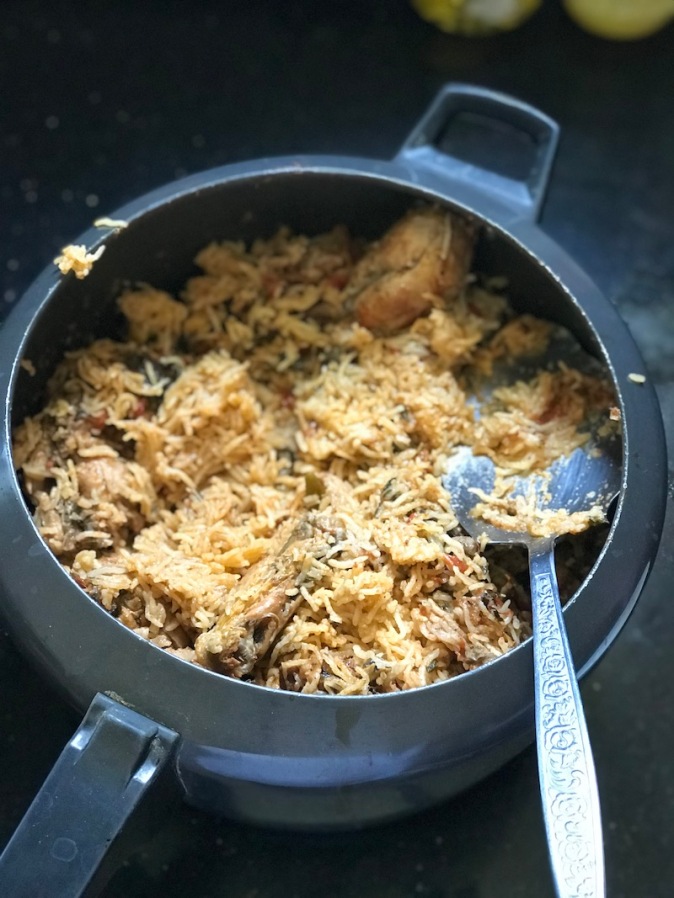 Ambur styled Biryani cooked in a pressure cooker. Originating in the region of Ambur, this spicy Biryani is paired with Khattay Baigan, the brinjal curry or a spicy and tangy Kathirikai Chutney, the brinjal chutney and cucumber raita.
Ambur styled Biryani cooked in a pressure cooker. Originating in the region of Ambur, this spicy Biryani is paired with Khattay Baigan, the brinjal curry or a spicy and tangy Kathirikai Chutney, the brinjal chutney and cucumber raita.
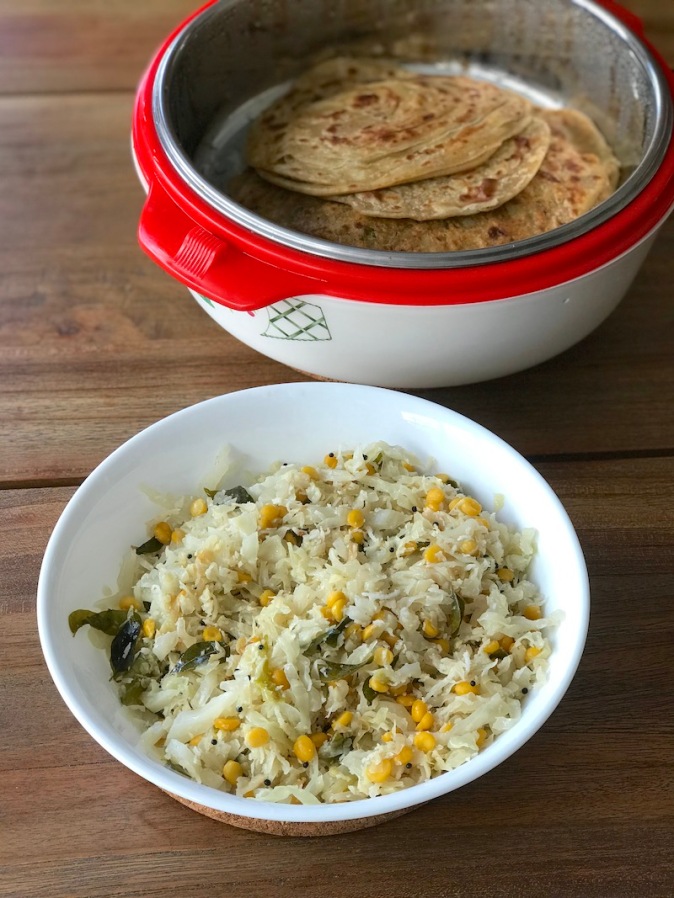
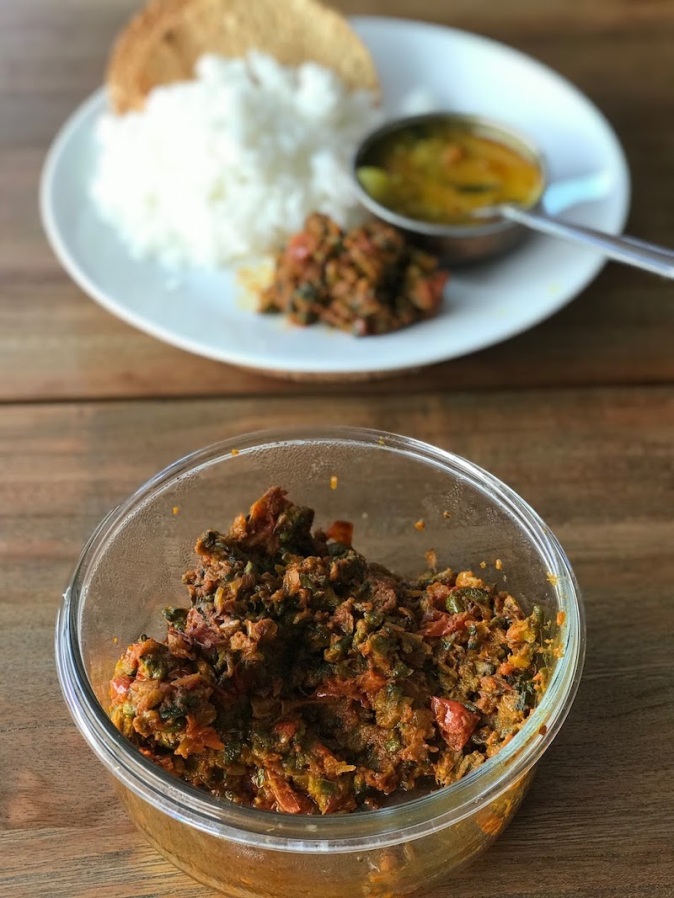 Poriyals are shallow fried or sauteéd vegetable dishes that can be made with every possible vegetable. Cabbage Poriyal with fresh grated coconut and bittergourd poriyal (first and second image above). In fact, amongst all the Poriyals I tasted so far, my favourites are the carrot-bean poriyal and the spicy bittergourd poriyal.
Poriyals are shallow fried or sauteéd vegetable dishes that can be made with every possible vegetable. Cabbage Poriyal with fresh grated coconut and bittergourd poriyal (first and second image above). In fact, amongst all the Poriyals I tasted so far, my favourites are the carrot-bean poriyal and the spicy bittergourd poriyal.
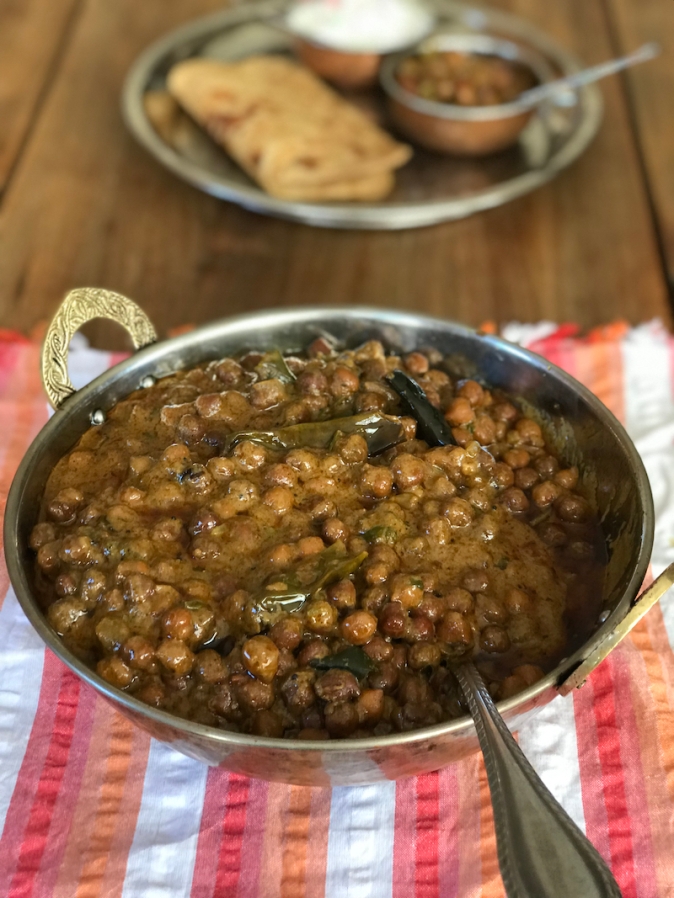
 Kadala Curry, a rich Kerala style black chickpea curry with triangular shaped homey Parathas with raita, the ‘Princess Raita’ as Matree calls it. She cooked the above dish in coconut oil and added a little coconut milk, making it really special for Maha Shivaratri
Kadala Curry, a rich Kerala style black chickpea curry with triangular shaped homey Parathas with raita, the ‘Princess Raita’ as Matree calls it. She cooked the above dish in coconut oil and added a little coconut milk, making it really special for Maha Shivaratri
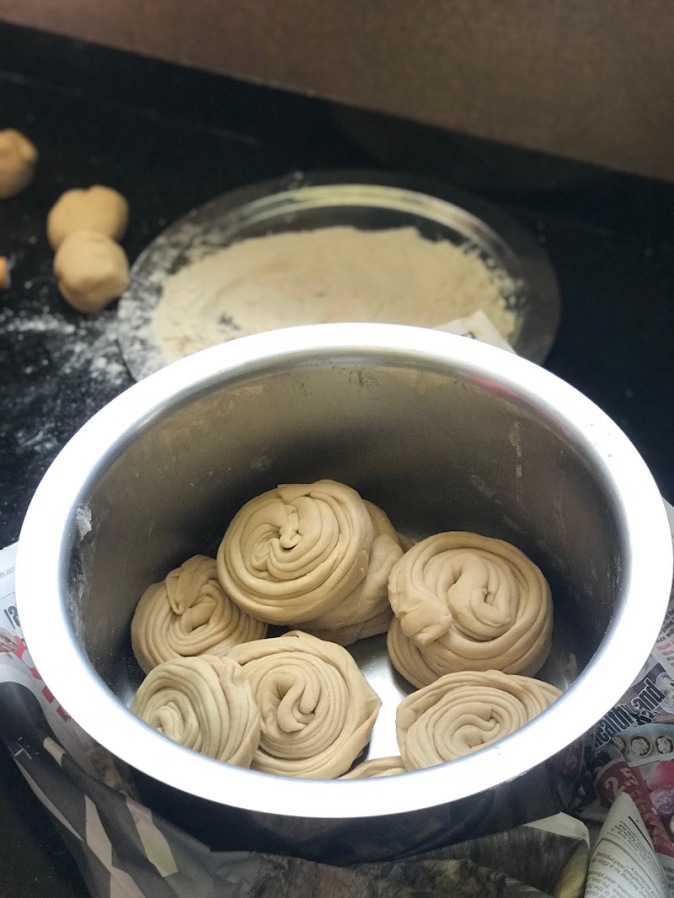
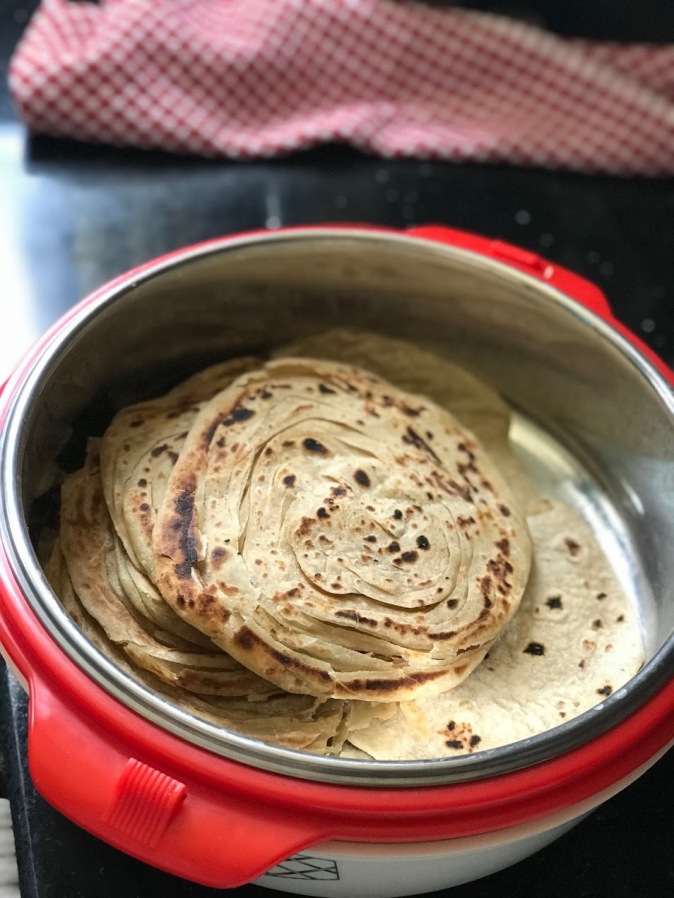
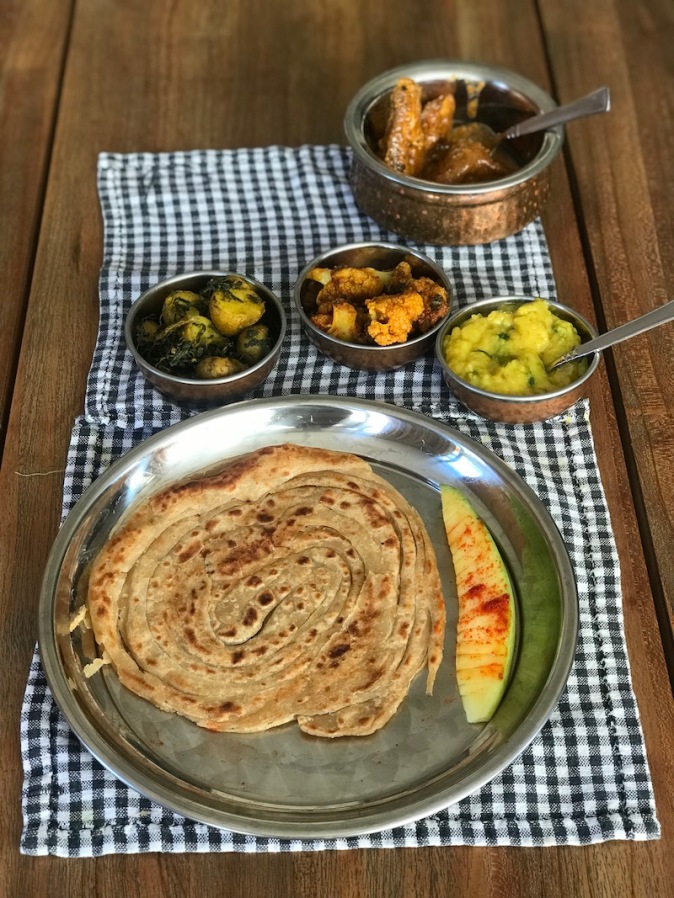
Malabari Parotta is the regional variant to Laccha Paratha in the way it is prepared. Its beauty lay in the layered manner in which the dough is rolled out and the subtle flakiness as ghee is added when the parathas are cooked.
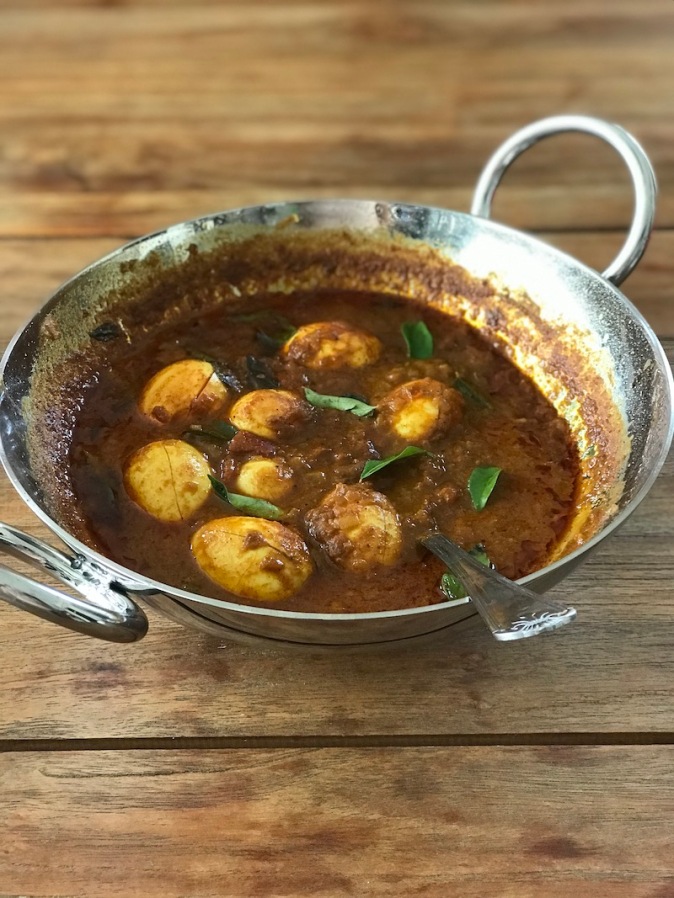
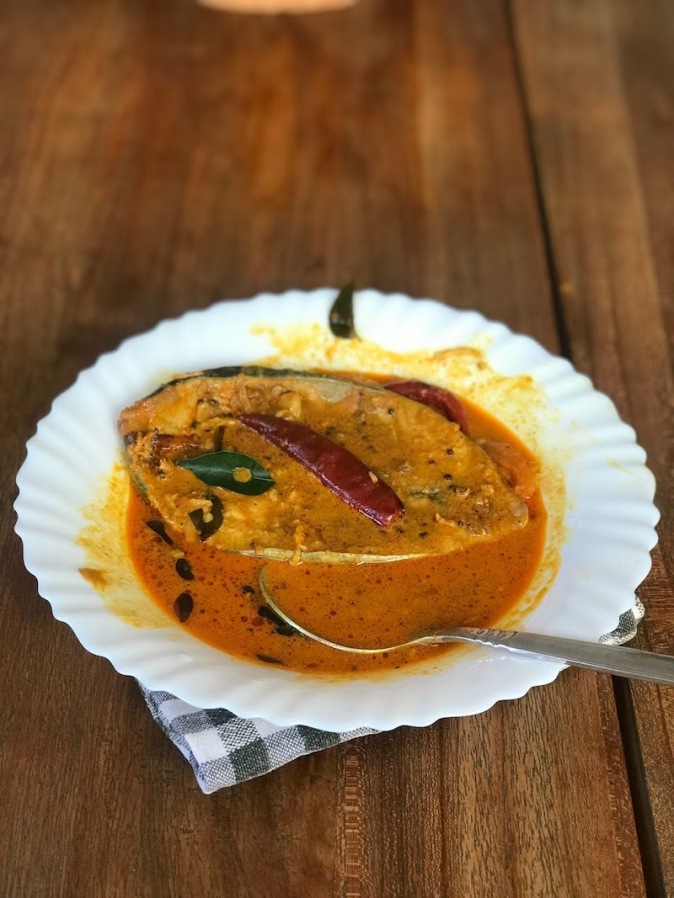
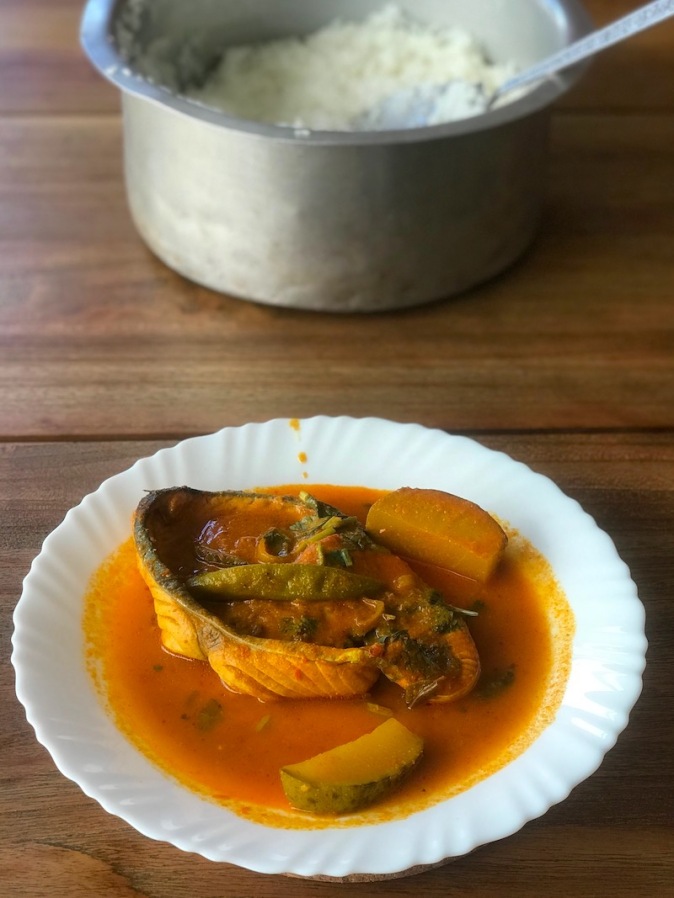 Meen Kuzhambu / Kulambu is a fish gravy cooked in tamarind, coconut milk and spices. I learnt to cook this from a reputed seafood restaurant in Chennai. While mine tasted quite similar to the one Matree cooked later (the second picture above), she made hers with pieces of green mango that added a whole new layer of spunk to the Vanjiram or Kingfish gravy.
Meen Kuzhambu / Kulambu is a fish gravy cooked in tamarind, coconut milk and spices. I learnt to cook this from a reputed seafood restaurant in Chennai. While mine tasted quite similar to the one Matree cooked later (the second picture above), she made hers with pieces of green mango that added a whole new layer of spunk to the Vanjiram or Kingfish gravy.
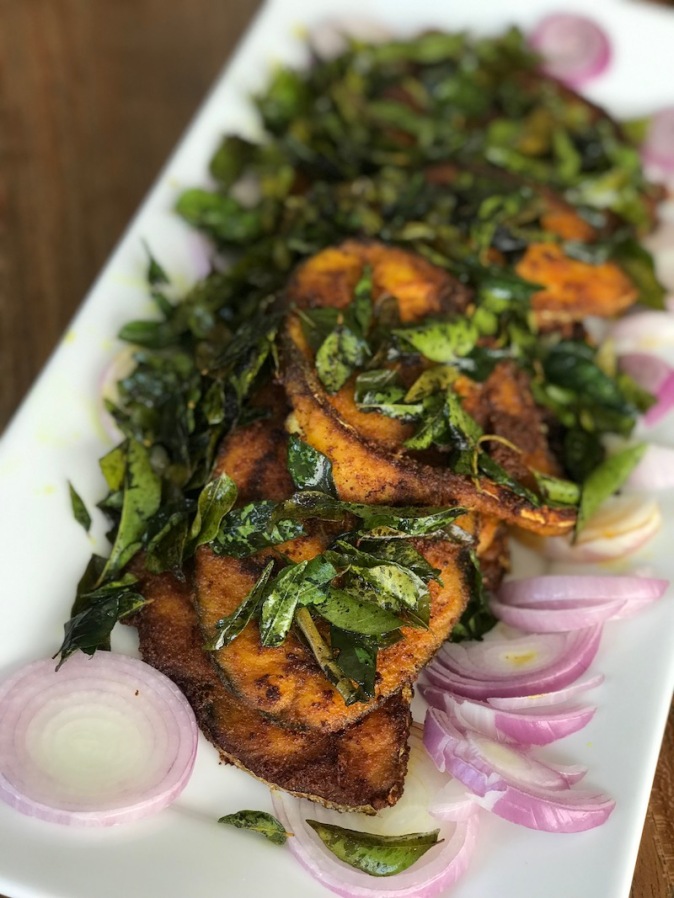 Fried Vanjiram or Kingfish, Kerala style
Fried Vanjiram or Kingfish, Kerala style

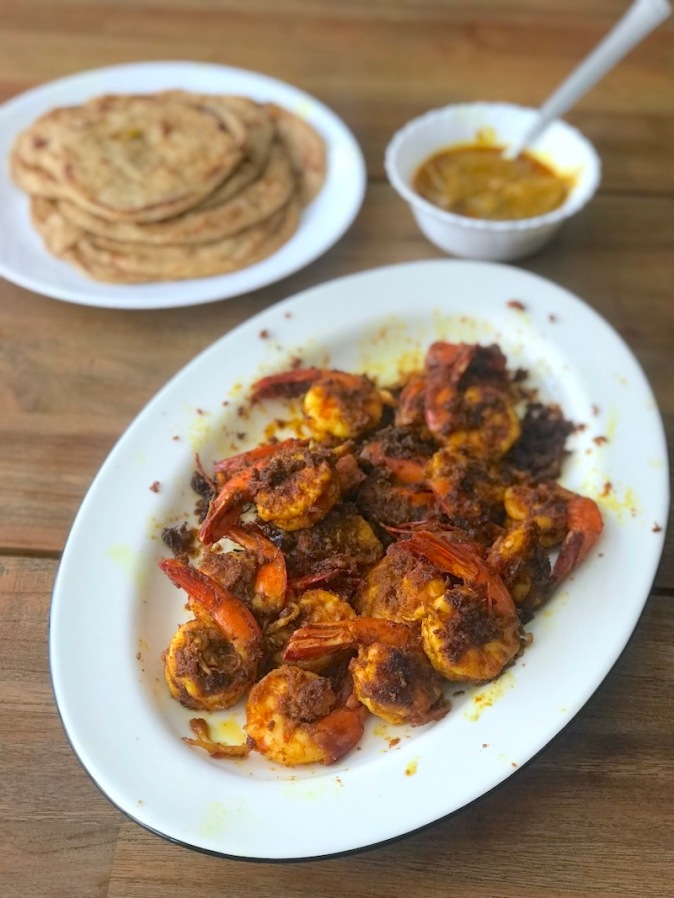 Kerala style Spicy fried prawns and Kerala style Coconut Fish Curry with the perfect accompaniment of homemade Malabari Parota.
Kerala style Spicy fried prawns and Kerala style Coconut Fish Curry with the perfect accompaniment of homemade Malabari Parota.
 Last but not the least… Gun Powder or Idli Milagai Podi, the spicy powder made with coarsely grinding roasted spices. This powder is quite versatile and can be sprinkled over anything to spunk it up – a plain curd, the curd rice, uttapams and others.
Last but not the least… Gun Powder or Idli Milagai Podi, the spicy powder made with coarsely grinding roasted spices. This powder is quite versatile and can be sprinkled over anything to spunk it up – a plain curd, the curd rice, uttapams and others.
Plugging in a bit of nostalgia… alibi a local goli soda. And desserts to satiate my Bengali sweet tooth
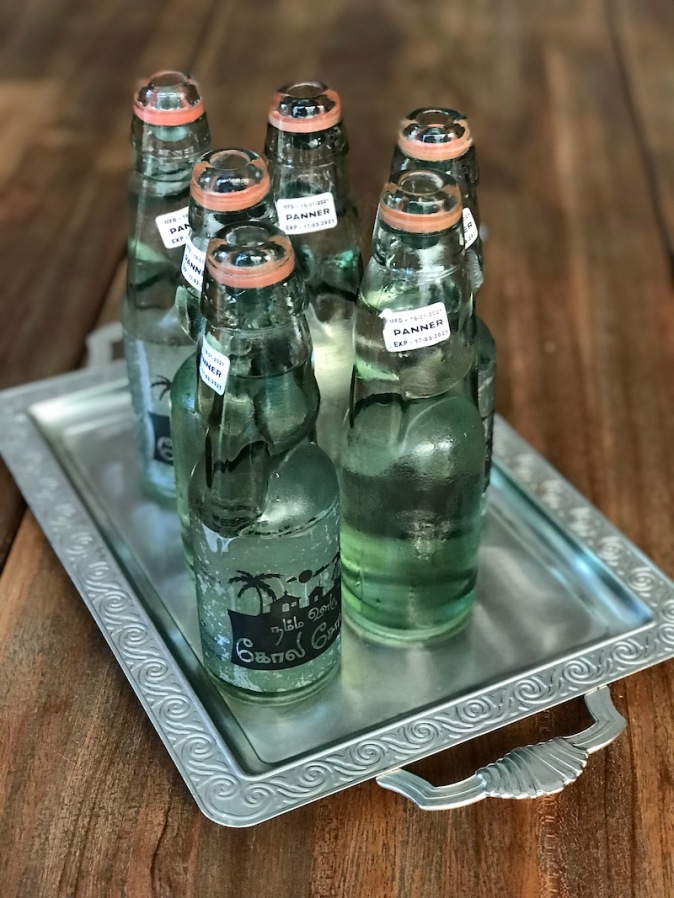 Panner or Paneer Soda. The word ‘Paneer’ means rose-water in Tamil, hence lending the name to the rose-water scented Goli Sodas… the taste of Paneer Soda is very close to one of my favourite drinks from my childhood… Bijoligrill’s Ice cream Soda.
Panner or Paneer Soda. The word ‘Paneer’ means rose-water in Tamil, hence lending the name to the rose-water scented Goli Sodas… the taste of Paneer Soda is very close to one of my favourite drinks from my childhood… Bijoligrill’s Ice cream Soda.
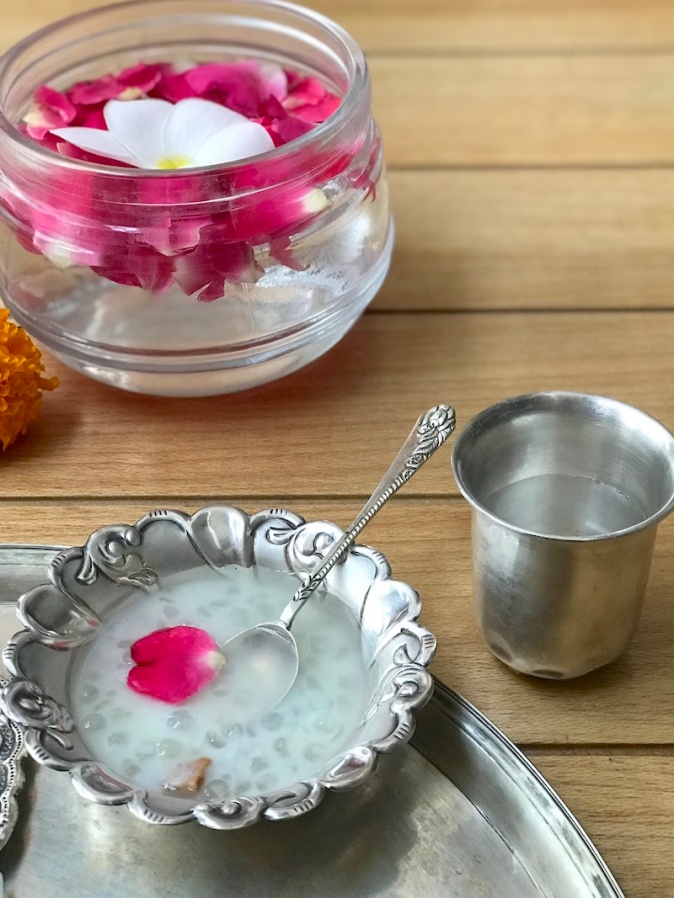 Javvarisi Payasam or milk pudding made with tapioca pearls as we celebrated Puthandu, the Tamil New Year at home.
Javvarisi Payasam or milk pudding made with tapioca pearls as we celebrated Puthandu, the Tamil New Year at home.
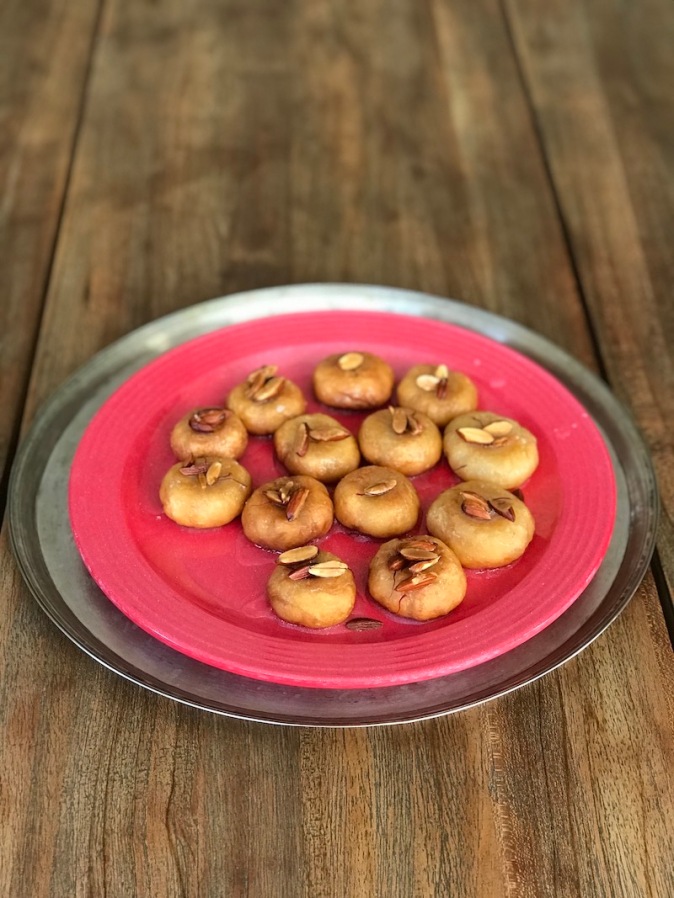 Badusha, fried dough balls glazed in sugar syrup
Badusha, fried dough balls glazed in sugar syrup
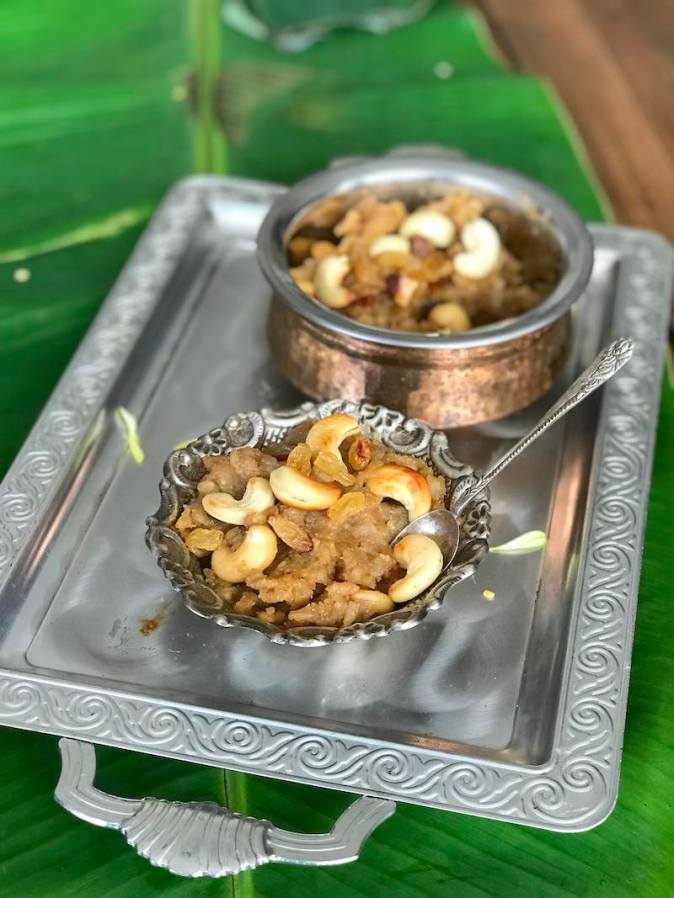 Sakkarai Pongal that we first had during Pongal, the harvest festival that’s celebrated in January
Sakkarai Pongal that we first had during Pongal, the harvest festival that’s celebrated in January
Before I crossed into the borders of South India… food wise
Before Matree joined us and led us on a culinary roller coaster ride of South Indian fare, our Indian meals comprised of whatever I conjured up on each day. Sometimes, the menu would simply pop up in my head the previous night, or sometimes it would be a prompt makeover out of the stock in our fridge. There have been many such dishes, sharing just a few of them (not Bengali food this time, excepting flexing the phulko luchi earlier on) …
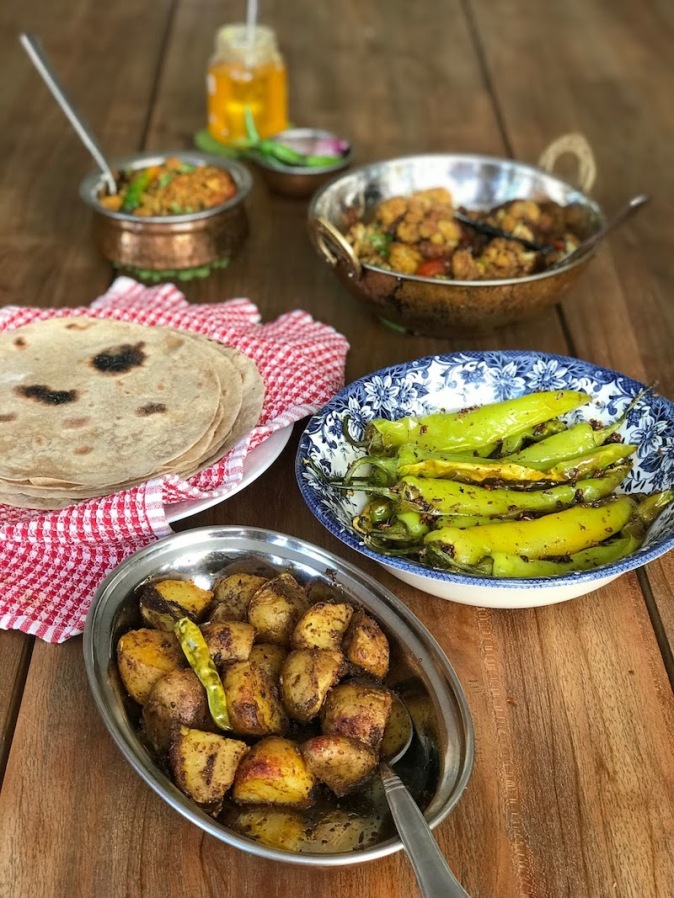 This was a nostalgic spin off on a lunch we had at a small highway eatery while travelling from Jaipur to Agra two years back. The above spread won my family’s hearts – ready made store bought chappattis, aloo or potato sabji, cauliflower sabji, long green peppers cooked in the manner of a pickle, a masala egg bhurji or scrambled egg cooked in a spicy dry gravy.
This was a nostalgic spin off on a lunch we had at a small highway eatery while travelling from Jaipur to Agra two years back. The above spread won my family’s hearts – ready made store bought chappattis, aloo or potato sabji, cauliflower sabji, long green peppers cooked in the manner of a pickle, a masala egg bhurji or scrambled egg cooked in a spicy dry gravy.
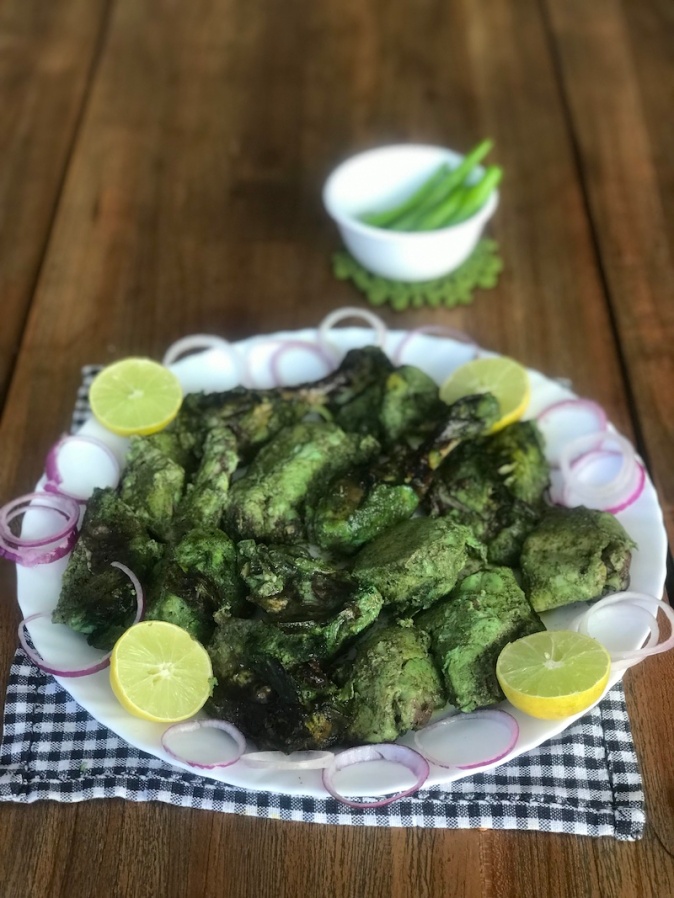 Grilled chicken marinated with spices, green chillies and fresh herbs like coriander and mint leaves
Grilled chicken marinated with spices, green chillies and fresh herbs like coriander and mint leaves
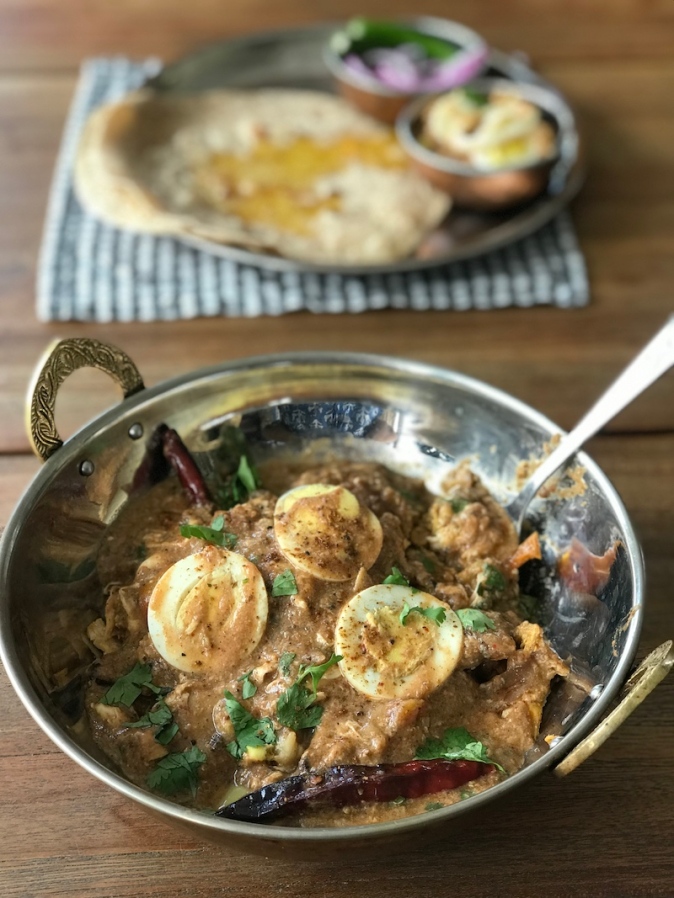 Chicken Bharta cooked in the style of Punjabi Dhaba at Ballygunge Phari in Kolkata
Chicken Bharta cooked in the style of Punjabi Dhaba at Ballygunge Phari in Kolkata
Sourcing meat, fish and meat … and super fresh vegetables
After resorting to the popular supermarket Nilgiris for groceries and its sister counterpart, Veggies for fresh fruits and vegetables initially, we have now expanded our horizon a bit.
From all the conversations within the community WhatsApp group, I have realised that there are many entrepreneurs and starts ups who are engaged in producing artisanal products and fresh organic produce of the highest quality. A lot of these fruits and vegetables with non-Indian origin, “fancy vegetables” as Matree calls them, are all grown somewhere in some farms in India right now. Orders can be placed over WhatsApp and products are promptly delivered home.
Referrals within known circles and word-of-mouth are the prime tools of publicity for much of these home-grown brands. We are loving the quality of the produce and mostly sticking to buying local produce of the season. Ansio sets up a weekly vegetable market within our community and I have already been initiated to a lot of regional vegetables like drumsticks, yams, different types of bananas and others.
We buy our fish from J K Fish Stall in Adyar as they seem to have a good stock of popular Bengali fish that are flown in from Kolkata daily. Whatsapp conversations with the Bearded Biker and his maachwala, the fish vendor ensures immediate home delivery of Bengali fish delicacies like Hilsa or “golda”, the freshwater giant prawns. The other day we bought fresh fish like Vanjiram or Kingfish, Sankara or red snapper and squids from the fishermen straight off the seashore in Kovalam. There couldn’t have a more exciting escapade for fish lovers like us. We order our chicken through online apps like Licious and Tender Cuts, sticking to the former for most of the times. A local butcher just outside our gate has sealed the Bearded Biker’s approval for meat – tender goat that I have perfected in slow cooking ala mum-in-law’s style. Sunday afternoons are now mostly reserved for slow cooked goat curry with big chunky aloo, or potatoes peeping out. The Bearded Biker has found fantastic pork supplier in SSD Meat World & Restaurant in Kilpauk, a bit far away from where we live. The restaurant serves popular pork dishes like sorpotel, vindaloo, chilli pepper fry and pork roasts, while they have their own farm is where the high quality meat is sourced. We recently discovered another place – a kind of a sanctuary very close to where we live, The Farm. It’s a B&B cum restaurant space located amidst rice fields, coconut groves and plantations. Apart from selling fresh produce grown in their own organic vegetable gardens, their product list is quite impressive, specially with the dairy products like Mozarella, Feta, Labneh etc. We recently started buying fresh milk from a dairy farm called Arunodhyam on recommendation from our neighbouring resident. Anju, the founder, spoke to me at length to share her story – how the dairy farm and the milking facilities is based out of her seaside residence. Initially, she was delivering to a few of her friends and its only during the lockdown period, more people got to know her because of word of mouth that led to her think of expansion. Recently, we ordered farm fresh watermelons, water apples and okras on repeat mode (images below) from Sri Durga Farms at Thirukazhukundram, a passion project founded by Maha and Raja, residents of our community. Every day there are messages in the residents’ whatsapp group, some friend or the other has some organic farm and growing something exotic… orders are immediately placed and the products delivered home promptly. Once we ordered oyster mushrooms that were absolutely brilliant!
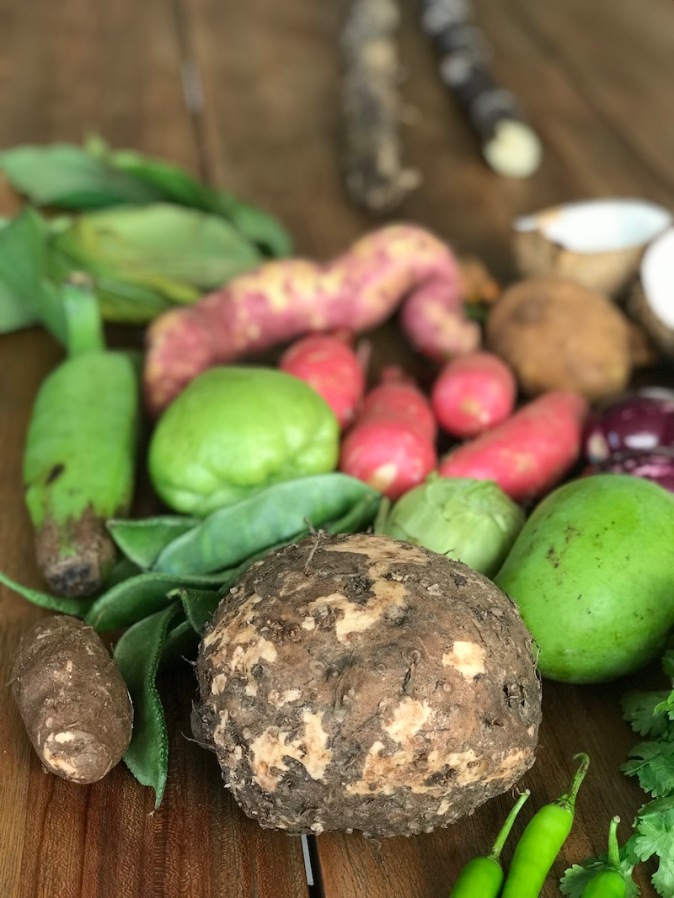
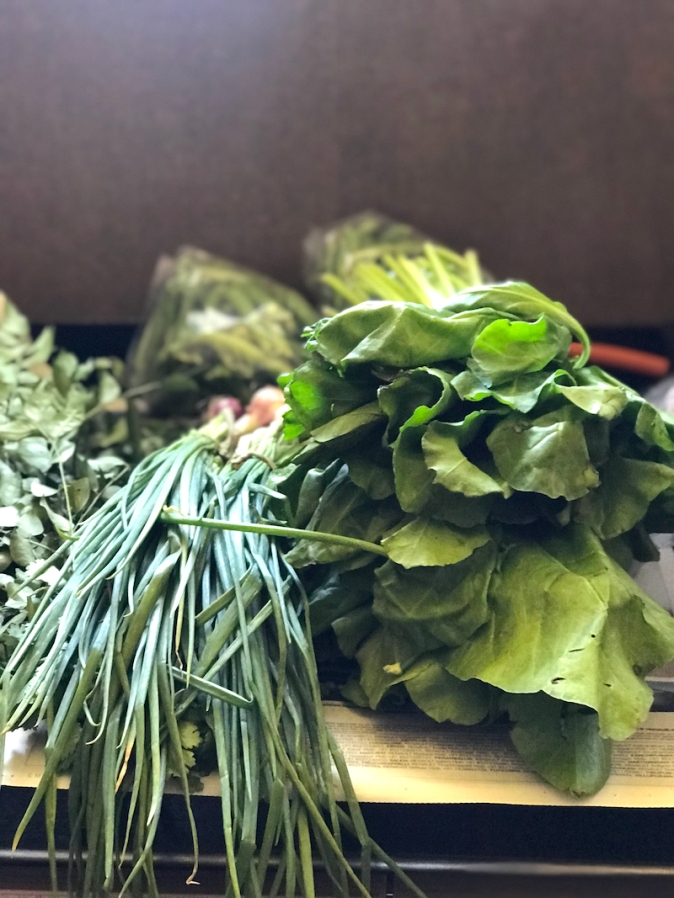
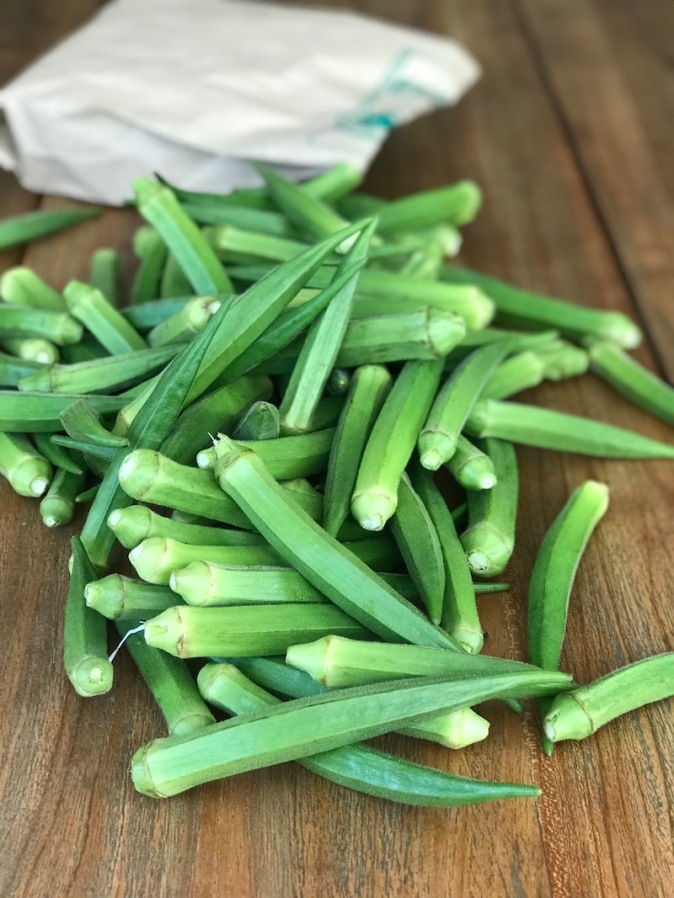
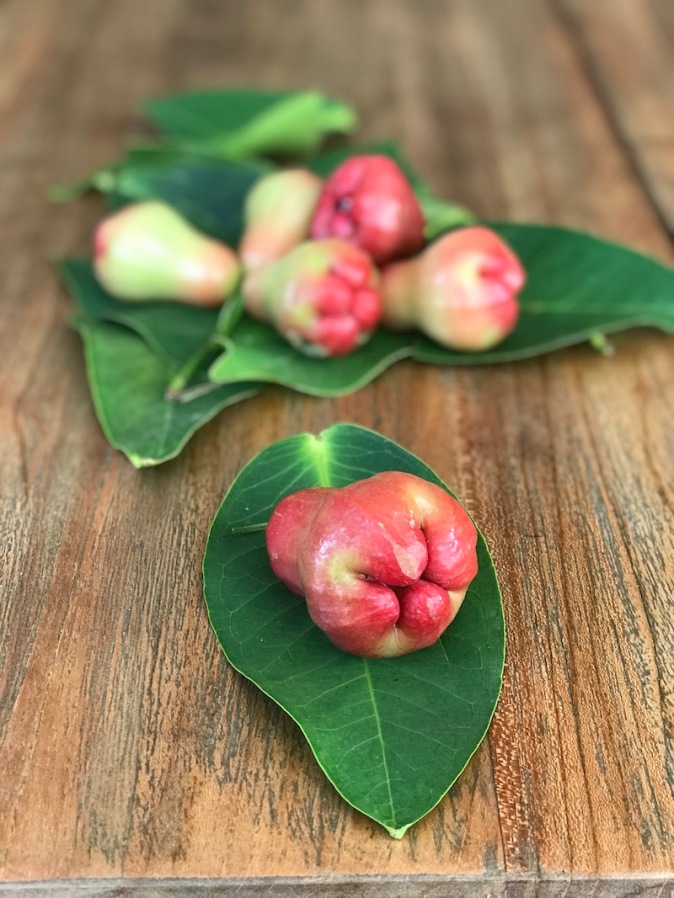
What inspires me to cook?
I believe that cooking entails an exchange of energy between the person who’s cooking any dish and the person who’s eating it. It’s an act of demonstration love and affection and should be performed as a rite – something that’s done from one’s heart. Matree listens to music – Tamil love songs while she cooks. She also entertains calls on her mobile. Initially, I had been slightly skeptic about the latter but after observing her for a few times, I have realised that she discusses what she’s cooking and there’s so much of happiness in her voice that it’s almost infectious. When she serves the food, there’s always a sense of excitement and she seems so happy to cook. When we plan the menu for the next day, there’s a lot of enthusiasm in sharing what she knows best. She also has some ‘vague’ dishes in her repertoire – Indian pasta and Indian noodles (the image below) made with Indian spices. Have you ever heard of Indian Mac and Cheese ? Well, just now you did!
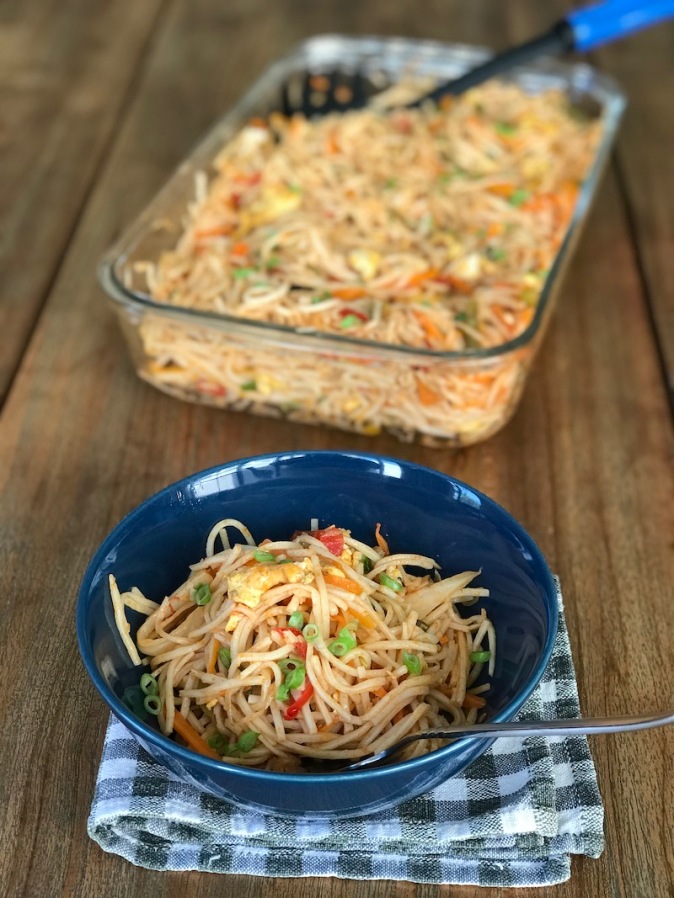
I am as inspired by cooks like Matree as I am by celebrity chefs like Gordon Ramsay. My shelves are full of signed cookbooks and my ‘to-cook’ list is filled with inspiration from the net, food bloggers I engage with, food addas with family and friends over whatsapp … and of course, our travels. Some of which, I shall reserve for a future post. For the time being, what is heartwarming is that when one starts celebrating local festivities at home, it’s sign that you have settled in well in one’s new home. As is evident from our Tamil festive sapadu last week as we celebrated Puthandu, the Tamil New Year!
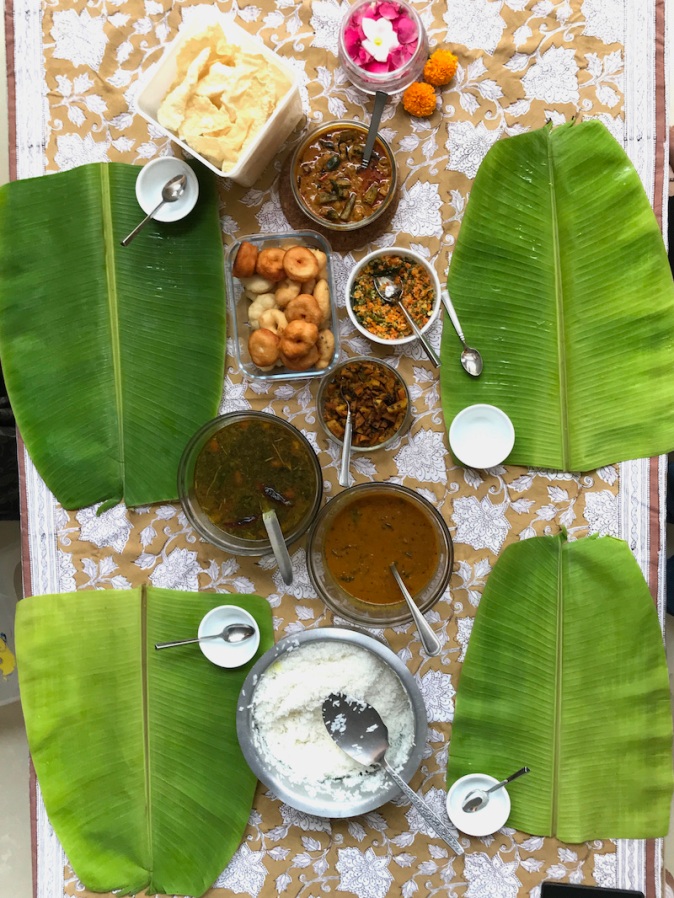
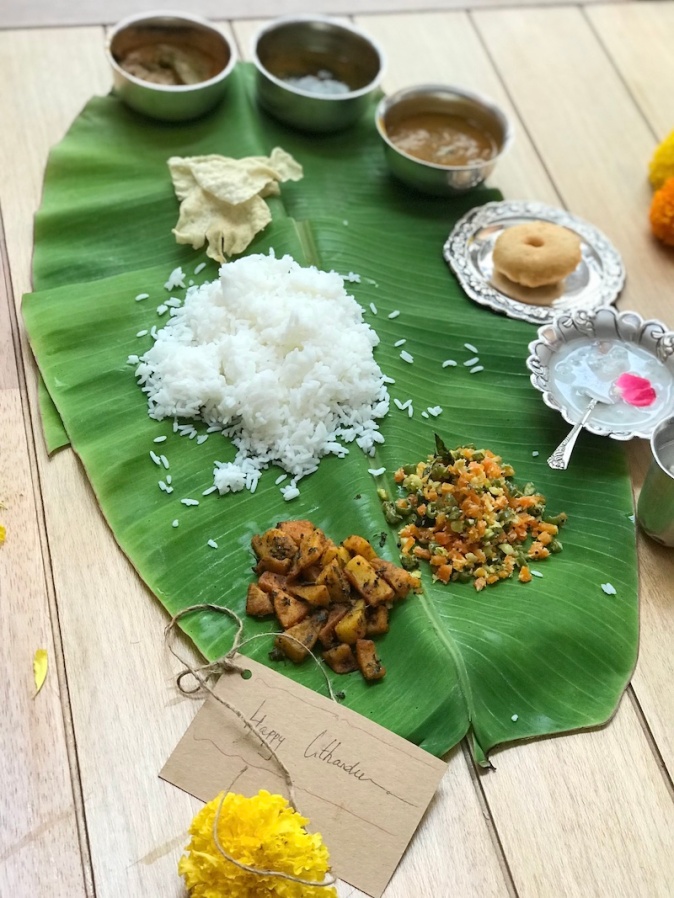
Unblogging it all… Ishita
Thank you for joining me on my daily food and travel journey on Pinterest, Instagram, Facebook and Twitter!
Some posts from my recent Chennai Chapter: Celebrating Bengali New Year and Tamil New Year at home Celebrating Pongal with Sakkarai Pongal and other dishes Kovalam Beach | Buying fish at the seashore and a recipe of Beer Battered Squid Finally calling Chennai home Chicken Chettinad cooked in a claypot Homemade spicy Chicken 65
Disclaimer: This isn’t a sponsored post, nor are there any affiliated links for any of the brands that may have been mentioned in this blogpost. The subject, story, opinions and views stated here are my own and all images are from my personal album. While you enjoy reading my posts with lot of visuals, please do not use any material from these posts.

